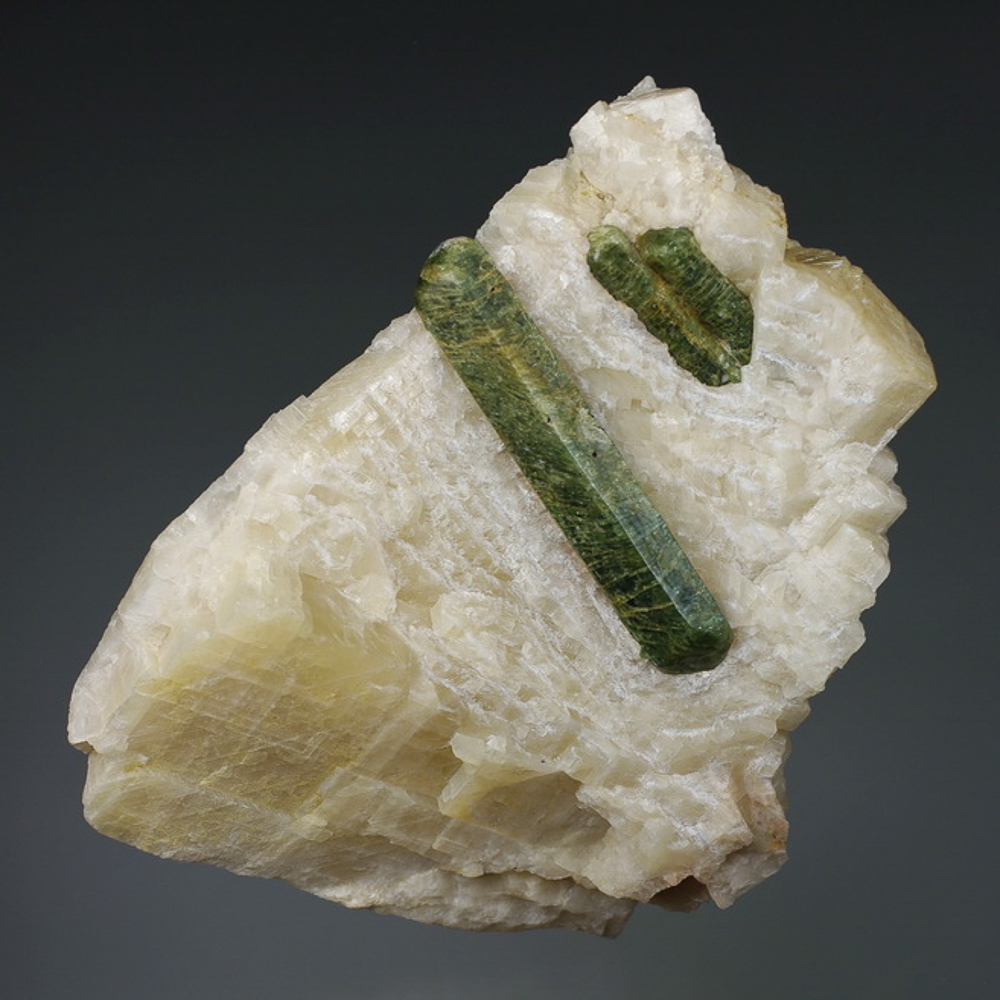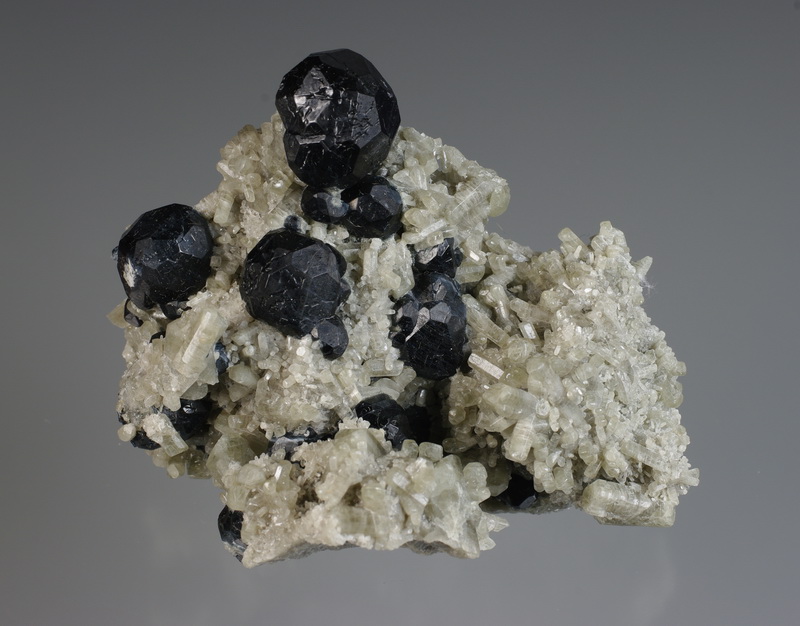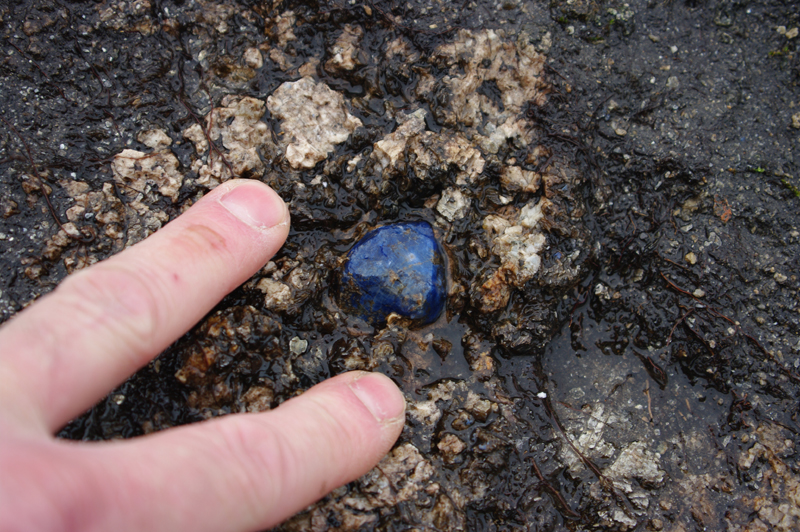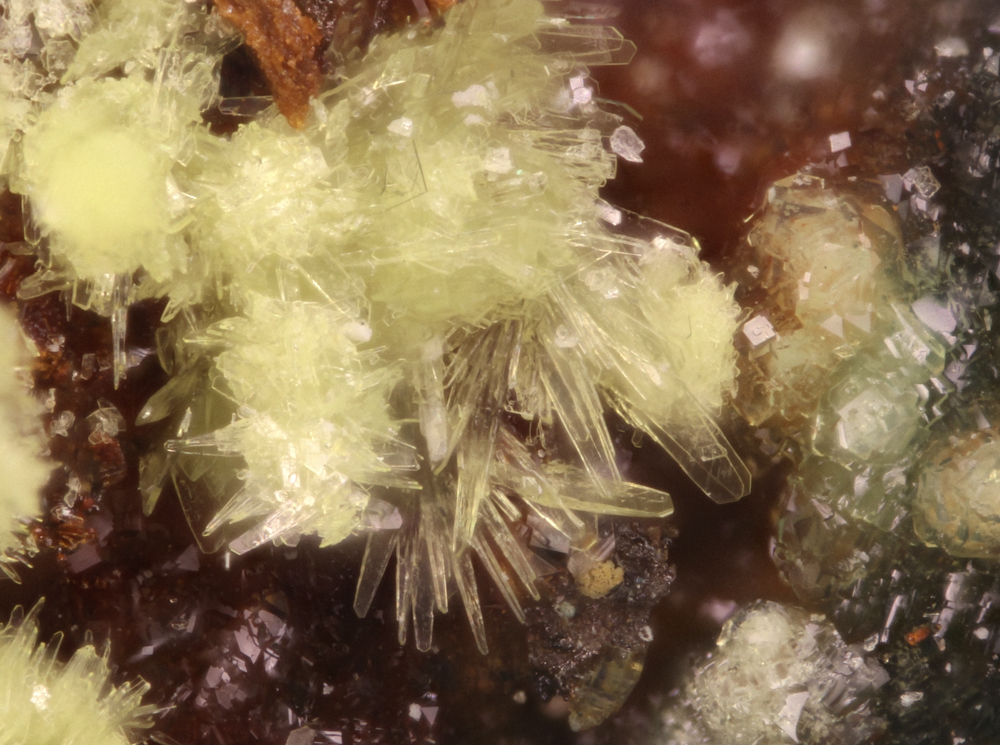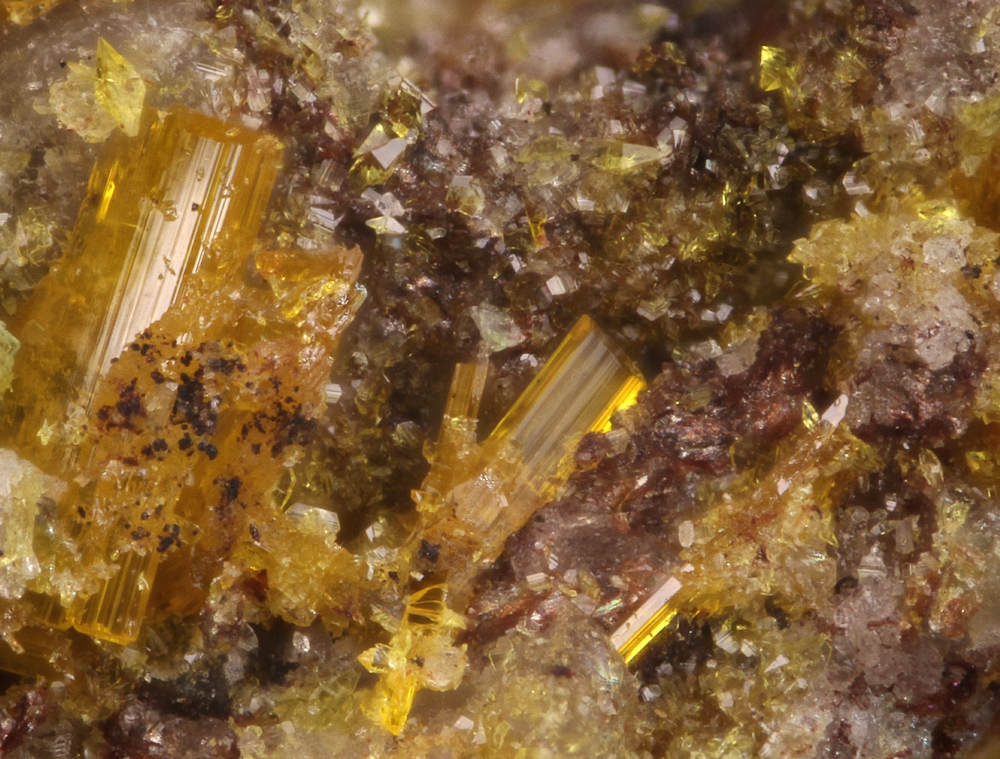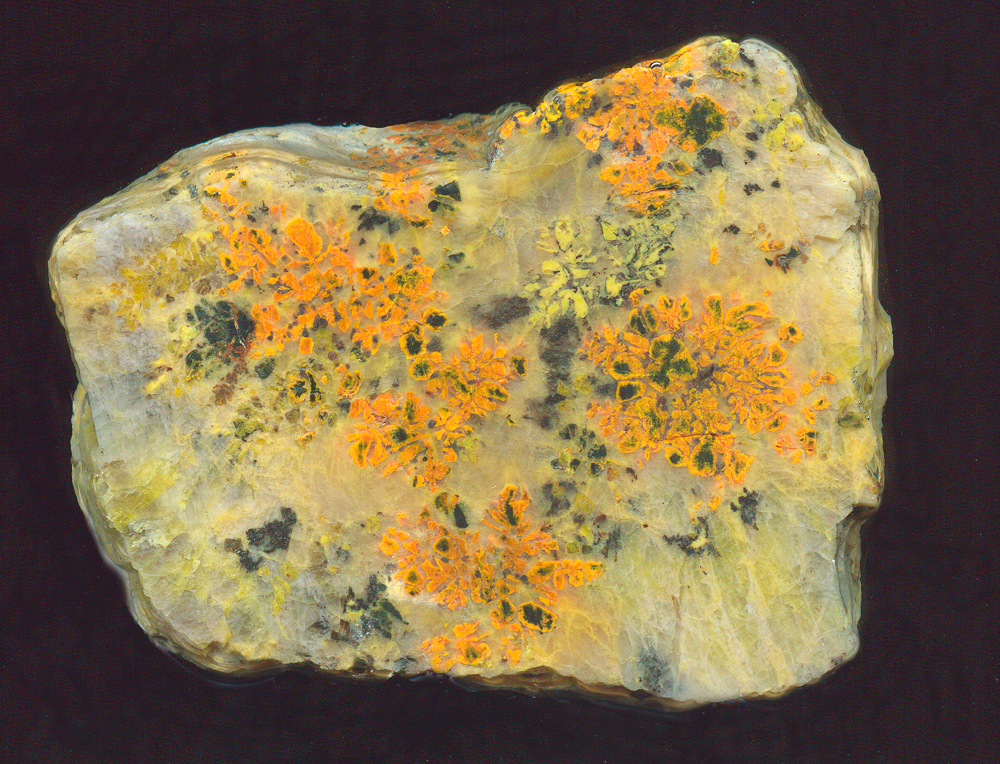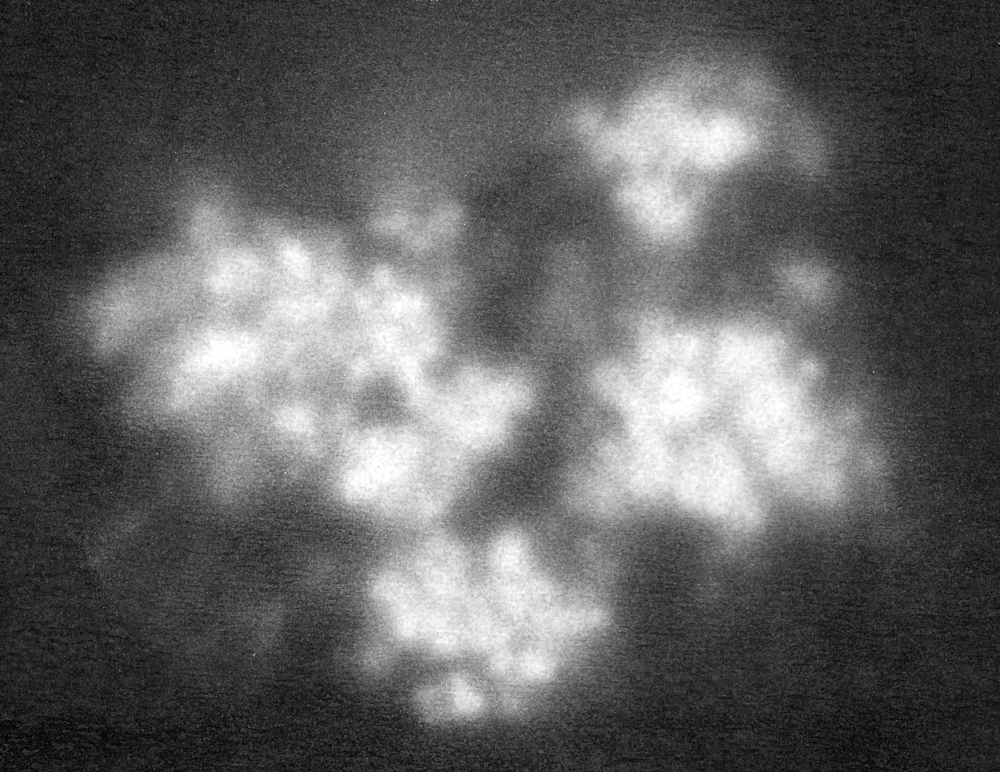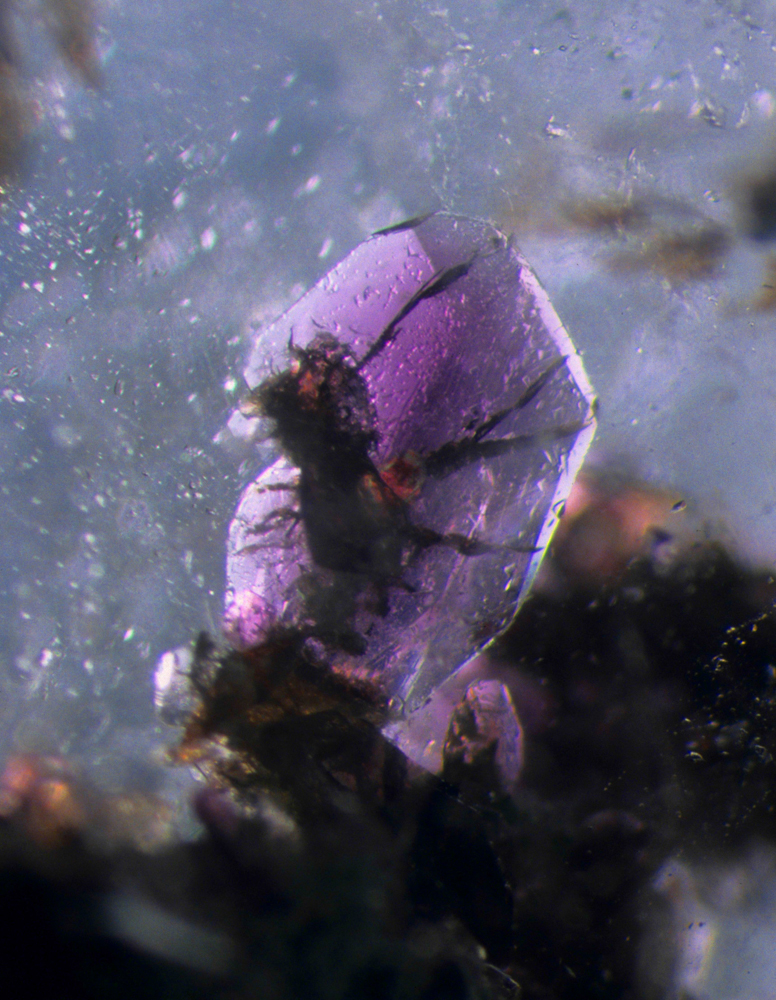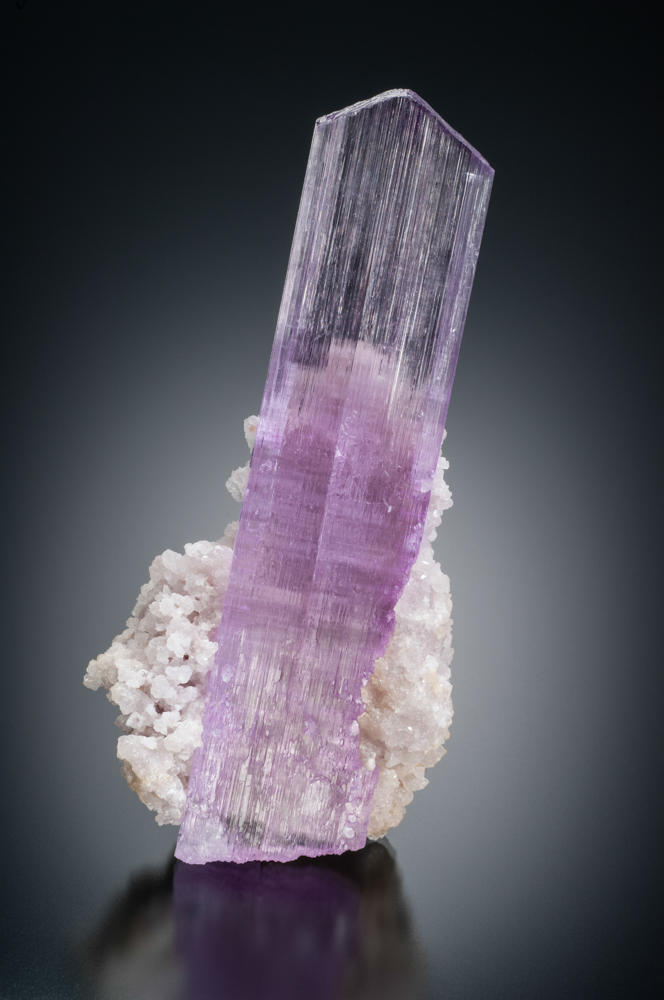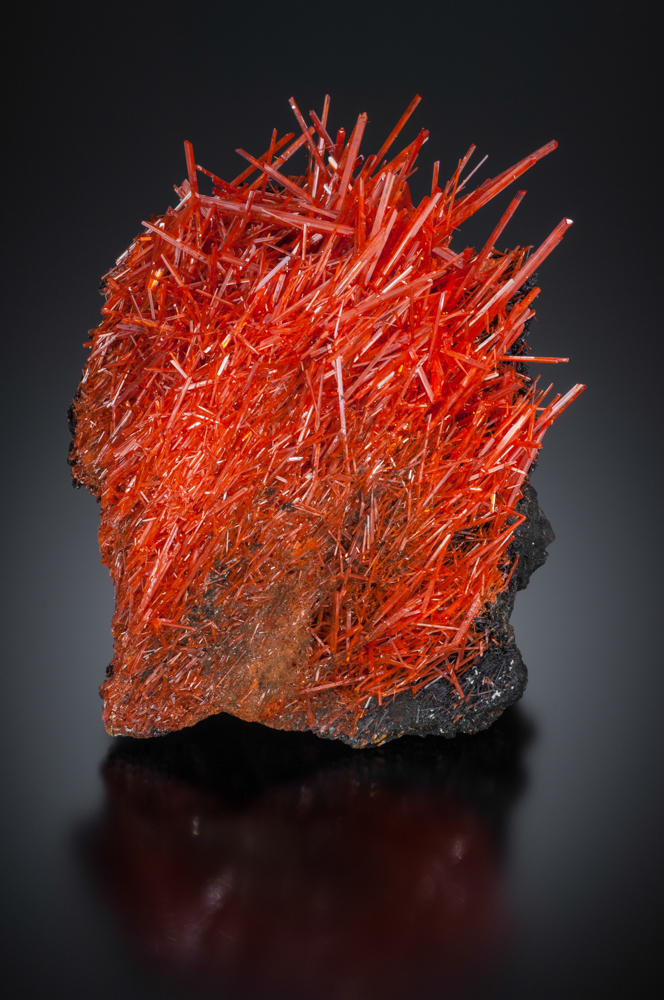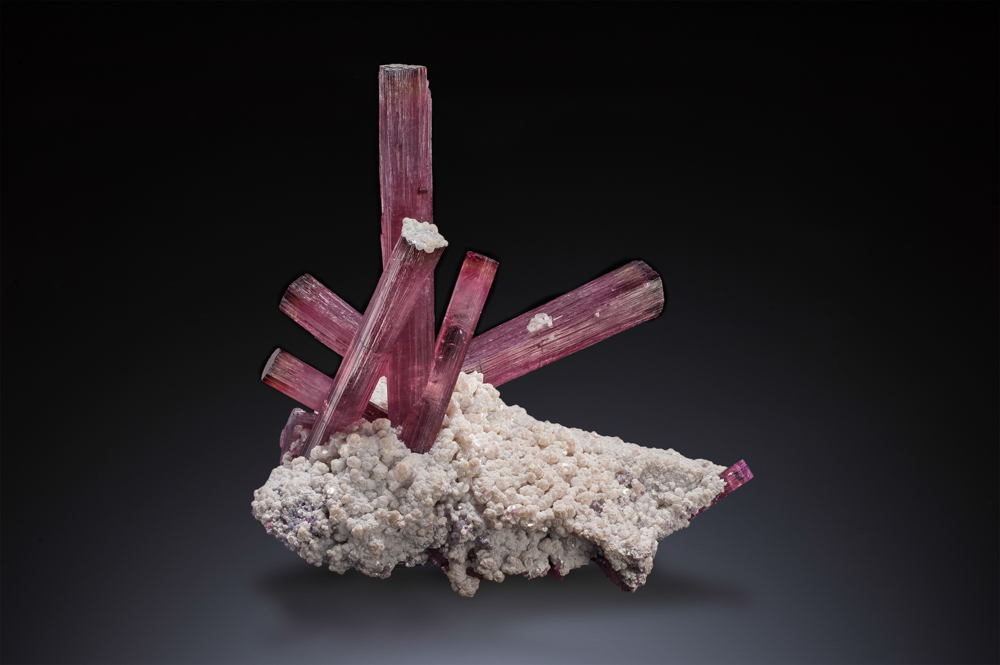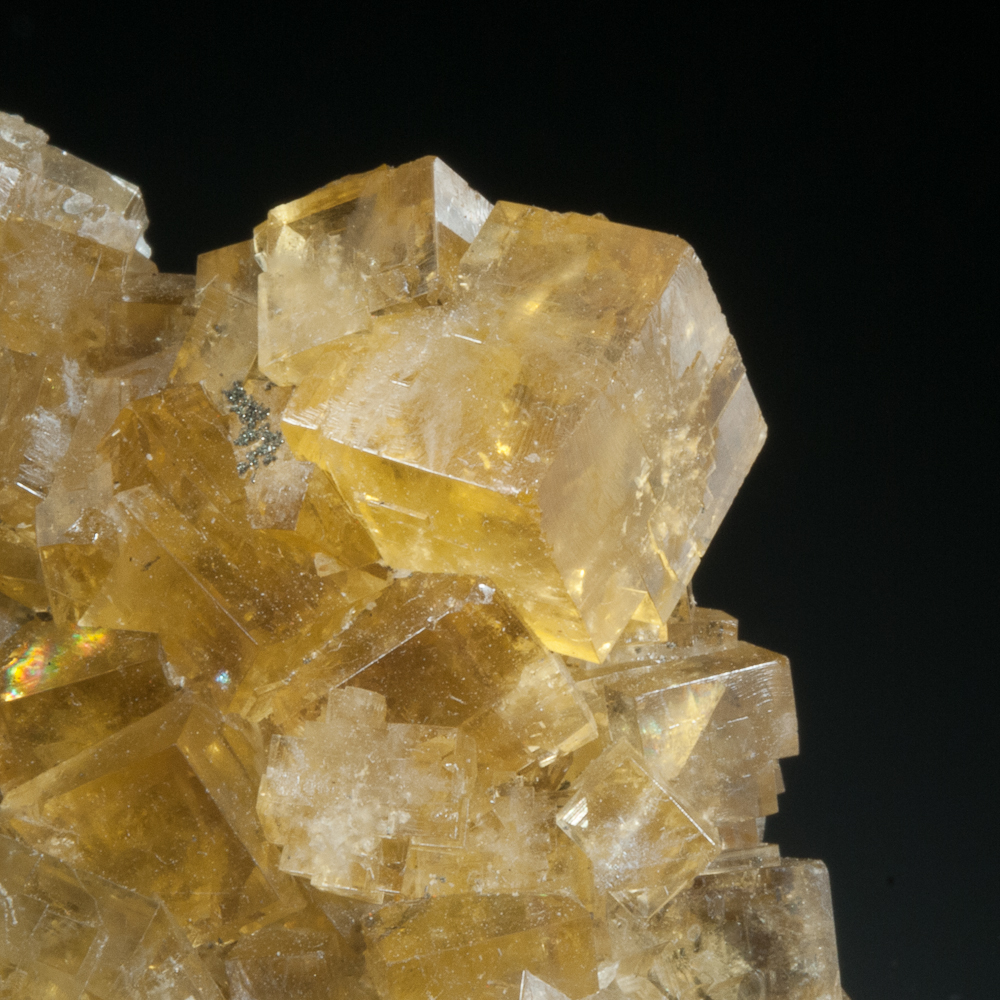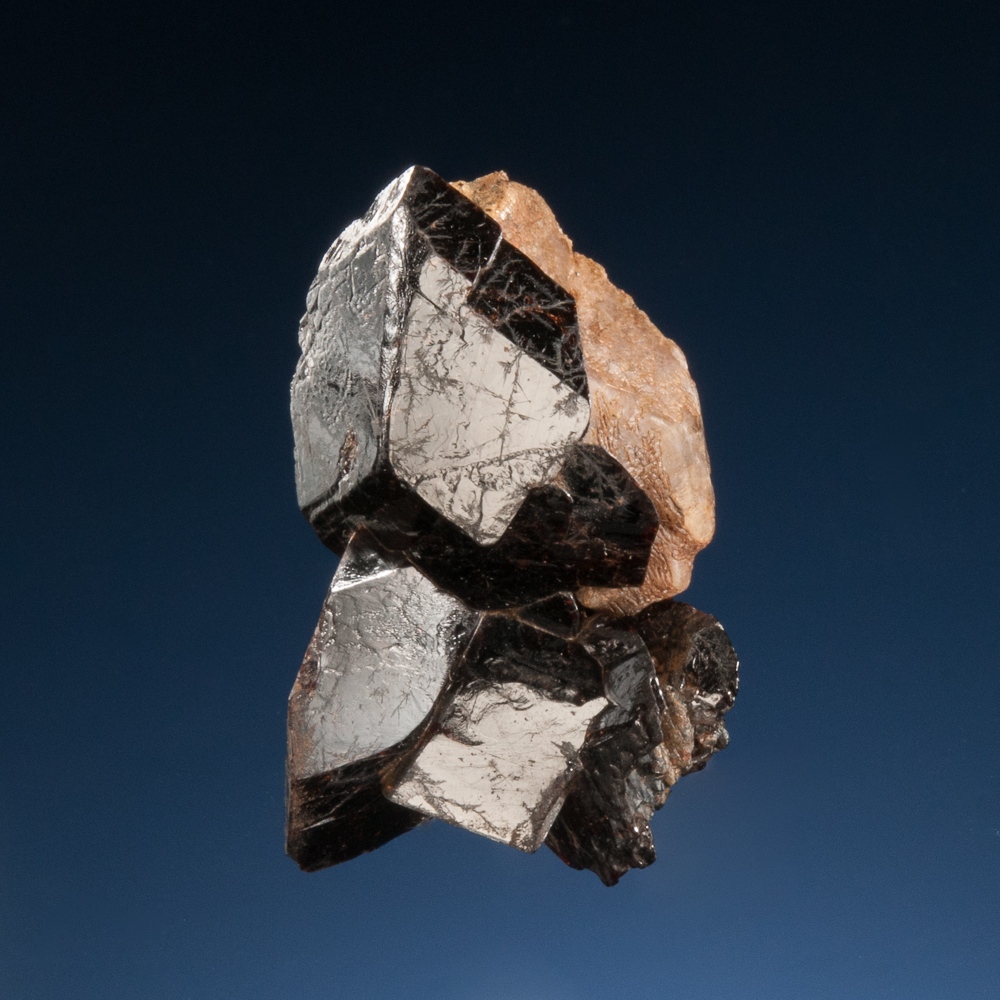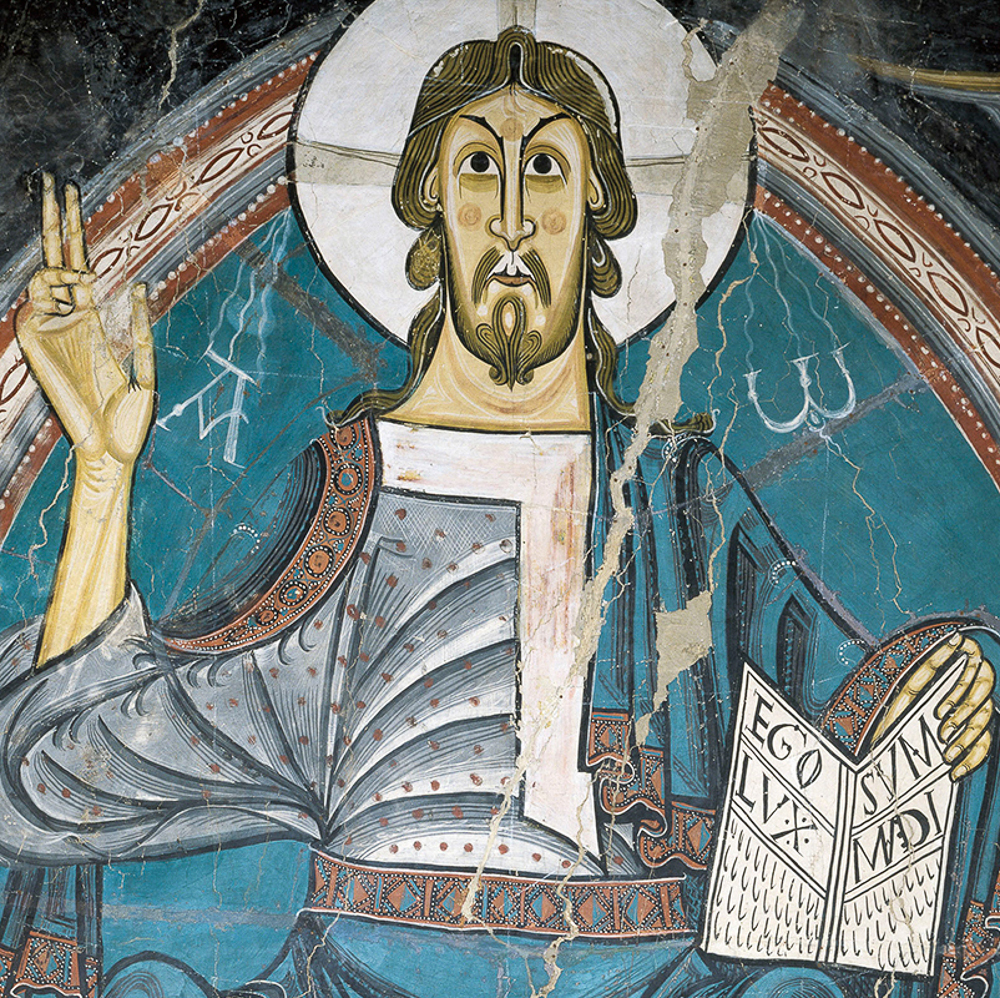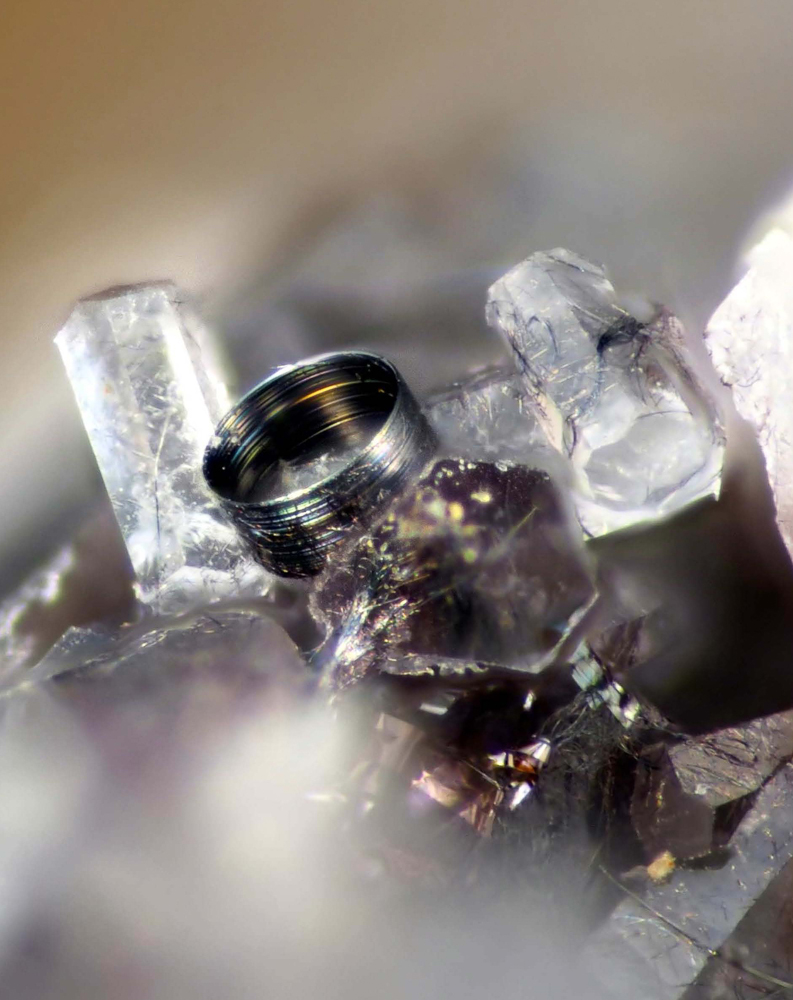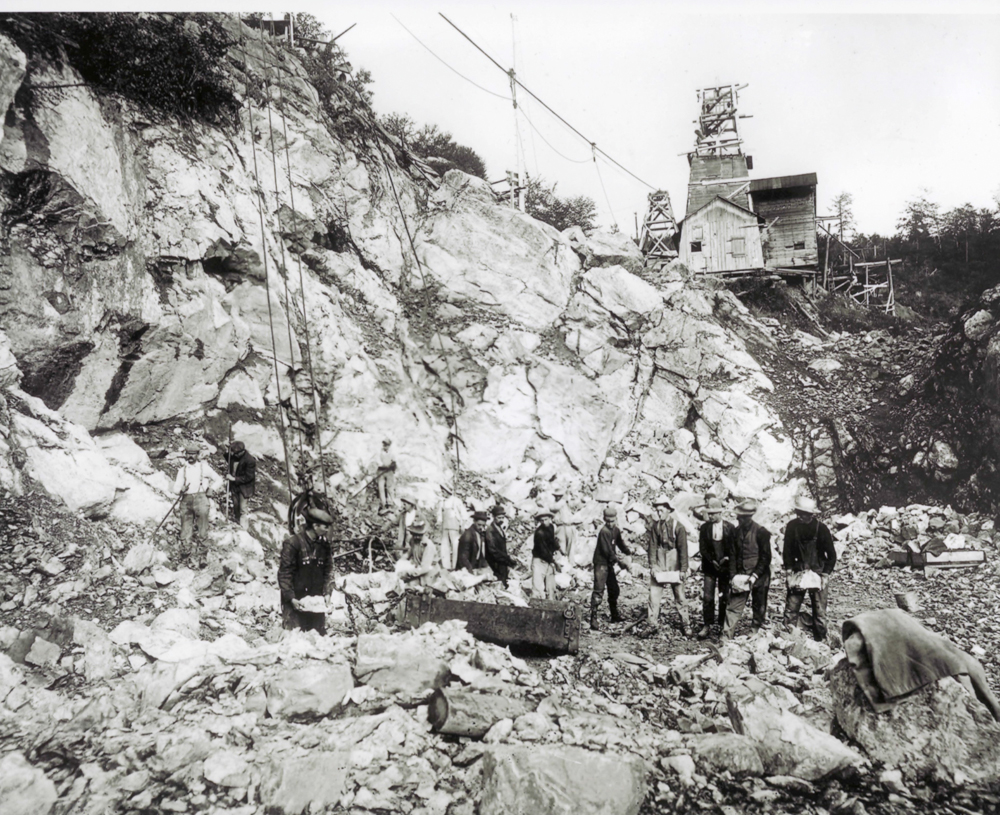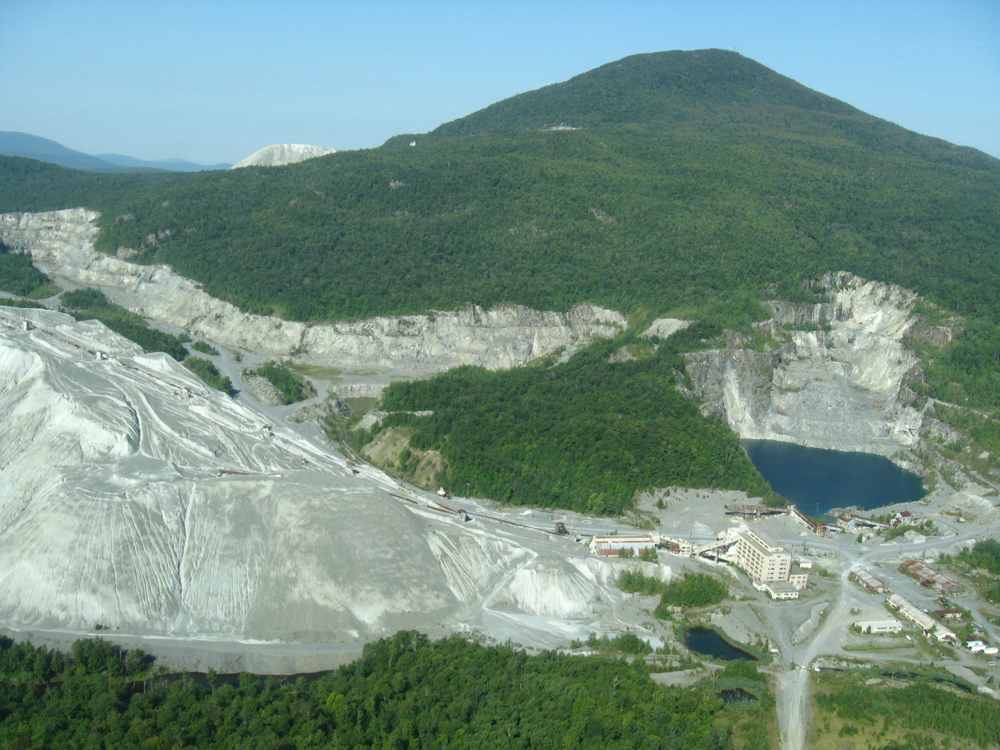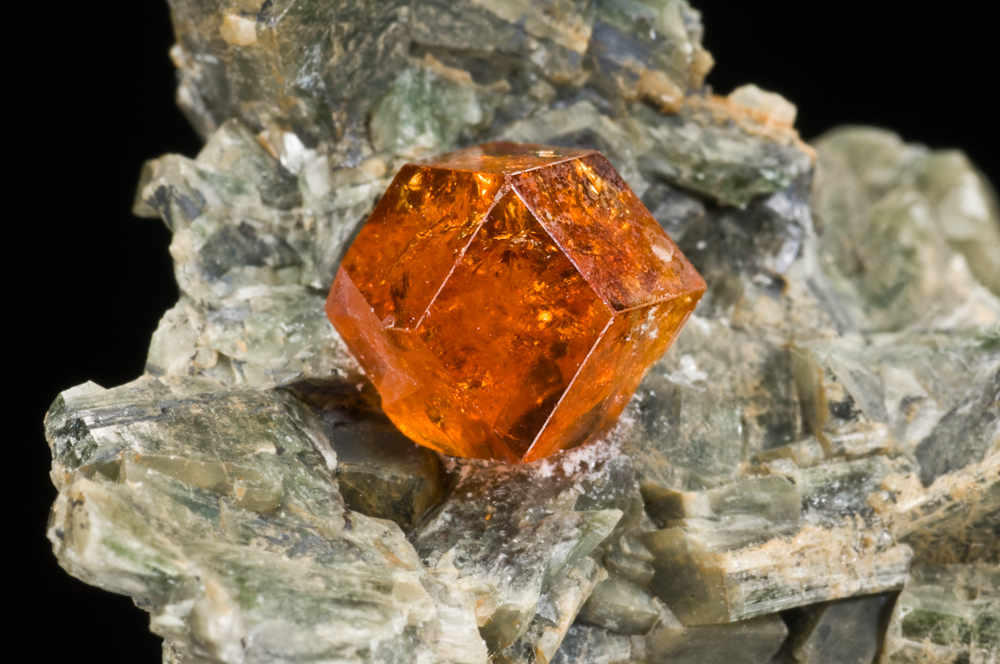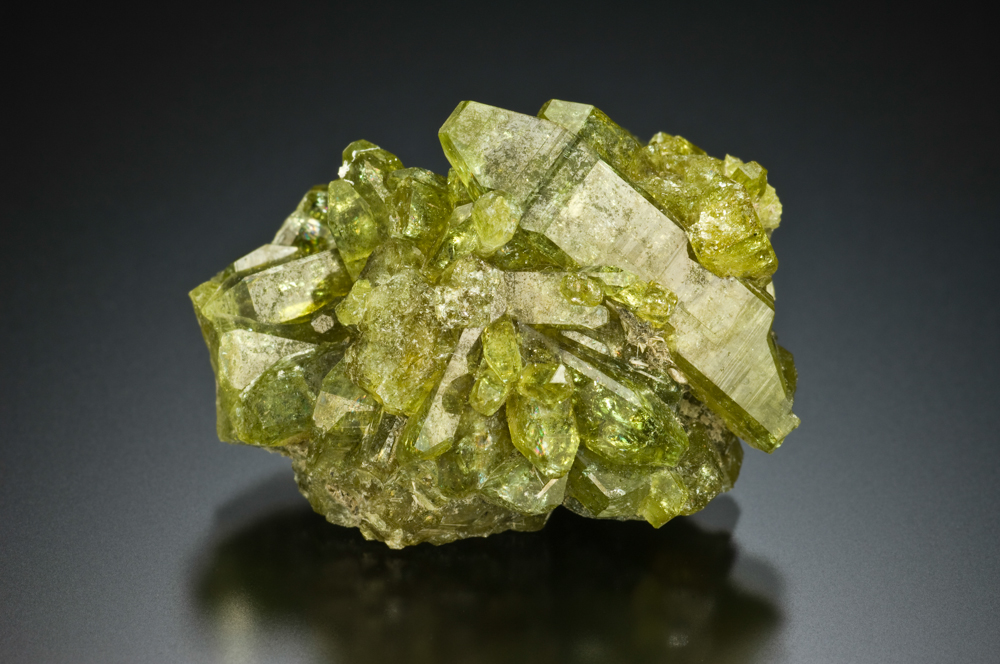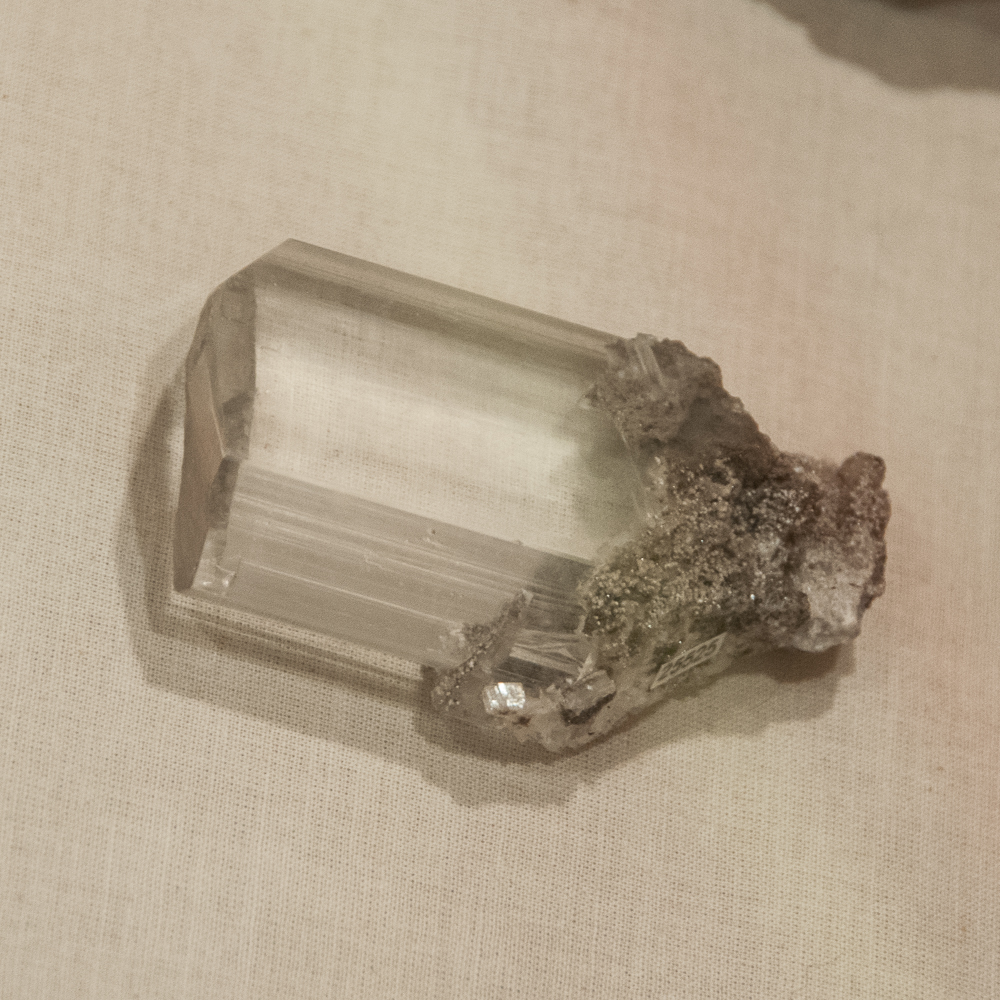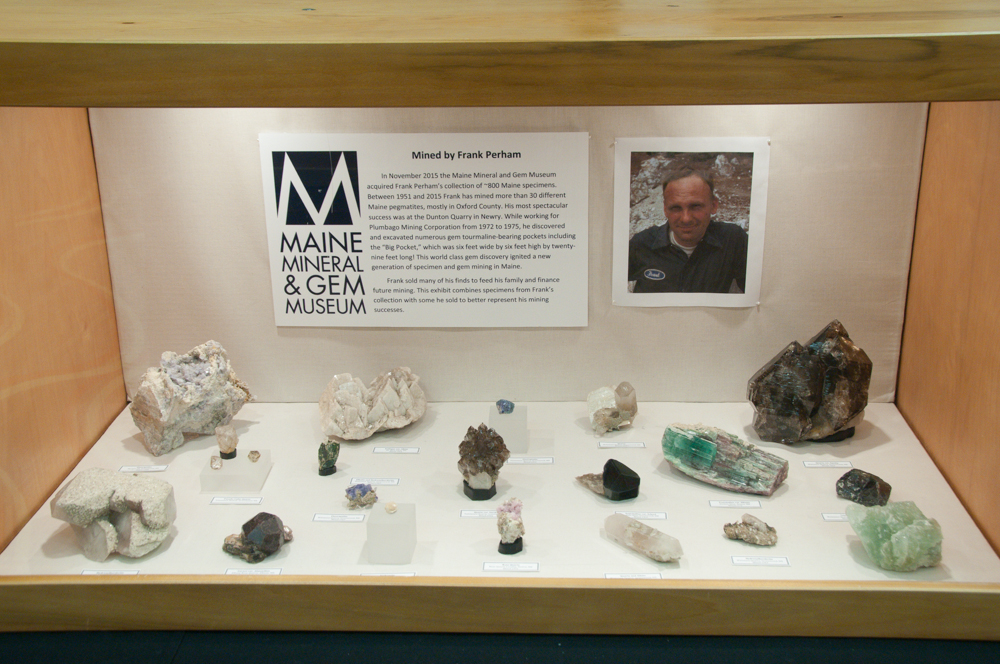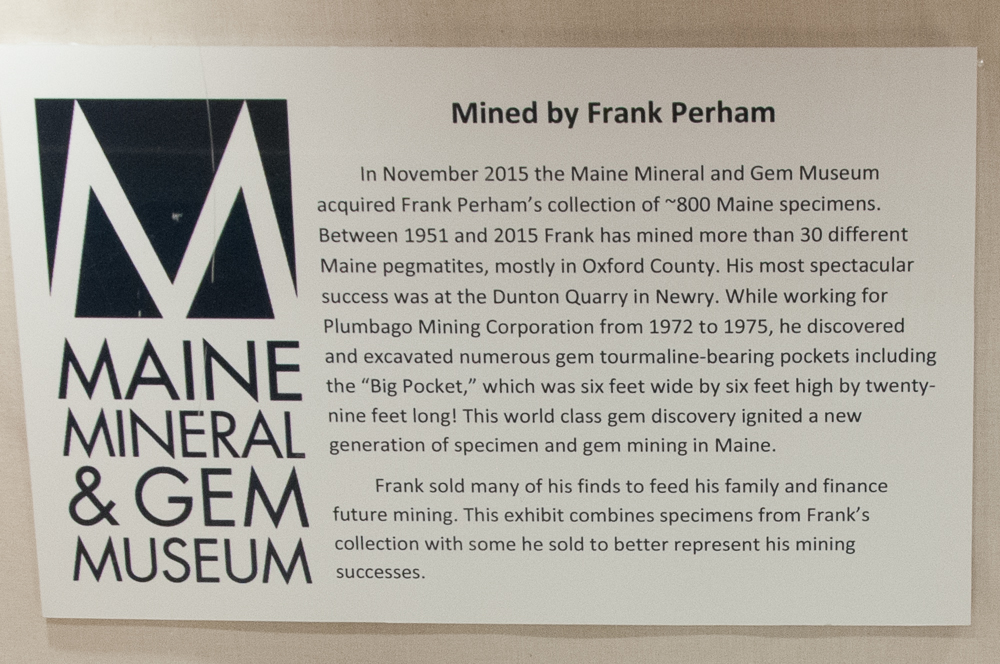Categories
Archives
There really is no event in the Mineral World year exactly like the Rochester Mineralogical Symposium. It may sound scientific and formal, but Rochester is perhaps the most welcoming and inclusive mineral gathering I know.
Rochester is not meant to be a strictly scientific symposium – it is meant for anyone who wants to learn more about topics in mineralogy. At Rochester, many of the best-known mineral people of our time, mineralogists, curators, collectors (including beginners) and students, all share and learn together. And we have a good time together too. How often, in any field of study, does one find this kind of collaboration and true camaraderie among people from the top of the profession through to early-stage amateur enthusiasts? It’s a great experience.
So if you’ve never come, why not plan to come next year? Rochester is meant for you as much as anyone! You can reserve the dates right now: April 20-23, 2017. The great 2017 speakers list is below…
2016 RMS Presentations
Our presentations this year spanned a real range of speakers and topics.
Thursday night we began with a talk about mineral adventure, to the southern coastline of Baffin Island, Nunavut, in Canada’s far north. This is the kind of adventure few of us will ever be able to (or would dare to) undertake. Our speaker was Brad Wilson. Brad is perhaps best known as a superb faceter of gemstones, from traditional coloured gemstones to rare and soft collector stones. He describes his trips as “part of my fearless love of nature”.
Have you ever seen anything like this from Baffin? (!)
Fluorapatite, Kimmirut, Baffin Island, Nunavut, Canada – 12 cm
B. Wilson specimen and photo
Over the years, during many trips, Brad has adventured for minerals in the far north of Canada – each of these trips is amazing. This is truly remote territory, with no settlements beyond Brad’s starting point, and he must fly his Zodiac watercraft from his home in Ontario to Baffin Island, so that he has a way to navigate the water. Once he’s out on his trip, he has no-one to rely on beyond himself, and he has nothing except what he takes with him! And when there are polar bears around, things can become less than ideal…
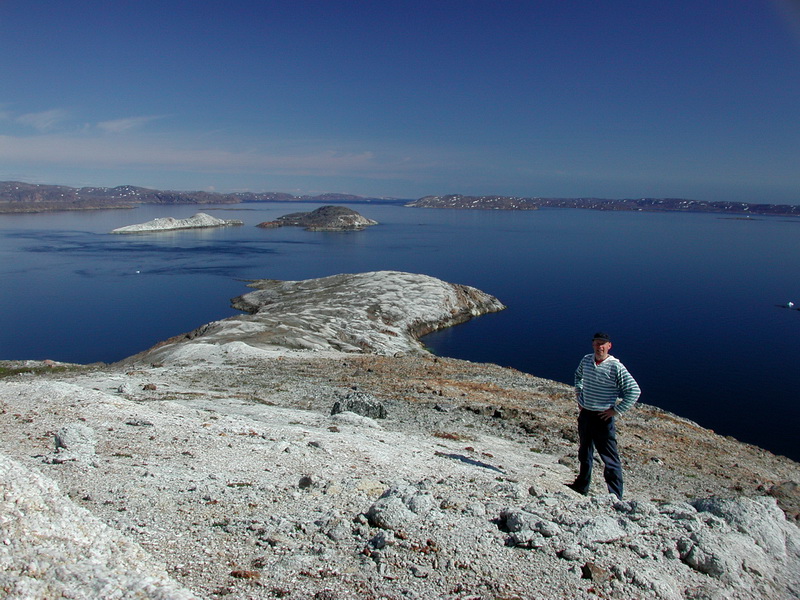
Brad Wilson, mineral adventuring solo along the southern coast of Baffin Island
B. Wilson photo
There is only limited literature and information about the geology and mineralogy of this region, so Brad has developed much of his knowledge from his travels. His discoveries have included superbly crystallized black spinel crystals, along with various minerals one might also find in calcite vein-dyke environments, such as titanite (to large-sized crystals).
Superb, complex spinel crystals with diopside, MacDonald Island, Nunavut, Canada – 7.5 cm
B. Wilson specimen and photo
Many of Brad’s finds to date have been indicative of enticing potential… what a colour…
Spinel (intense blue), Baffin Island, Nunavut, Canada
B. Wilson photo
Brad plans to continue to travel to Baffin in the future, and he hopes to bring back more amazing specimens – without any more polar bear encounters.
Changing gears entirely, Friday morning’s talks were about uranium minerals.
Dr. Peter Burns, is the current president of the IMA (International Mineralogical Association), Director of the Center for Sustainable Energy at University of Notre Dame, director of an energy frontier research centre, Materials Science of Actinides and a professor in several disciplines at Notre Dame. Upon reading that in the program, I wasn’t sure I’d be able to understand anything. How wrong I was to wonder! “The Societal Importance of Uranium Minerals and Mineral-Inspired Materials” explained many things about which I knew nothing, including uranium mineral structure. The compounds that combine in uranium minerals are limited by the unusual large size of the UO2 molecule. This molecule only combines with certain others in certain ways and this limits the diversity of uranium mineral compositions. We were treated to photographs of uranium minerals few of us find familiar.
Ewingite – Mg8Ca8(UO2)24(CO3)30O4(OH)12(H2O)138 – is a newly-described mineral from the Czech Republic, and its structure contains the largest cluster known in a mineral, at about 2.4 nm across with 24 U atoms per cluster.
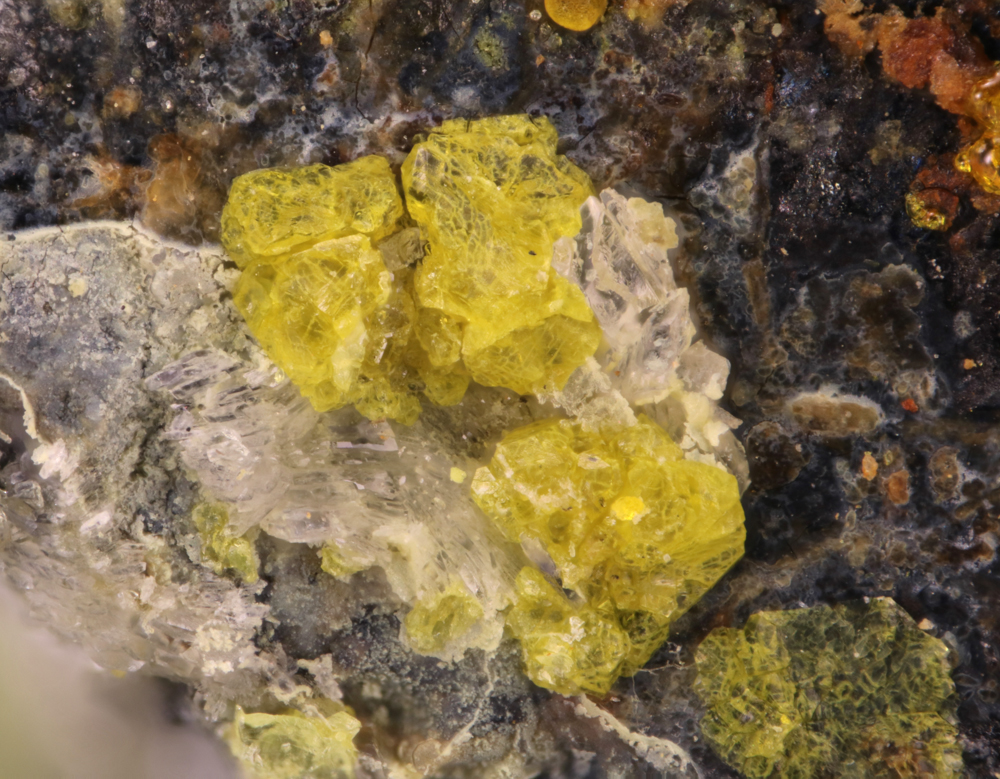
Ewingite, Plavno Mine, Plavno, Krušné Hory Mts (Erzgebirge) Bohemia, Czech Republic.
Field of view 1 mm. Travis Olds photo.
Leoszilardite, Markey Mine, Red Canyon, White Canyon District, San Juan Co., Utah, USA
Field of view 1.5 mm. Travis Olds photo.
Gauthierite, Shinkolobwe Mine, Shinkolobwe, Katanga Copper Crescent, Katanga, Democratic Republic of Congo
Field of view 1.2 mm. Travis Olds photo.
We also learned that the study of uranium mineral structures and uranium compounds is producing results that may lead to significant new applications. One particularly interesting example is the manipulation of actinide (including uranium) cluster structures and creation of compound structures that may be used in uranium reprocessing, to recover uranium from spent fuel at nuclear facilities.
Next, Dr. Robert Lauf spoke on the Mineralogy of Uranium and Thorium. You likely know he is a well-known author of books on specimen mineralogy (the Collector’s Guide series). His presentation included explanations and many mineral photographs, excellent specimens in stunning colours, and some rather uncommon minerals.
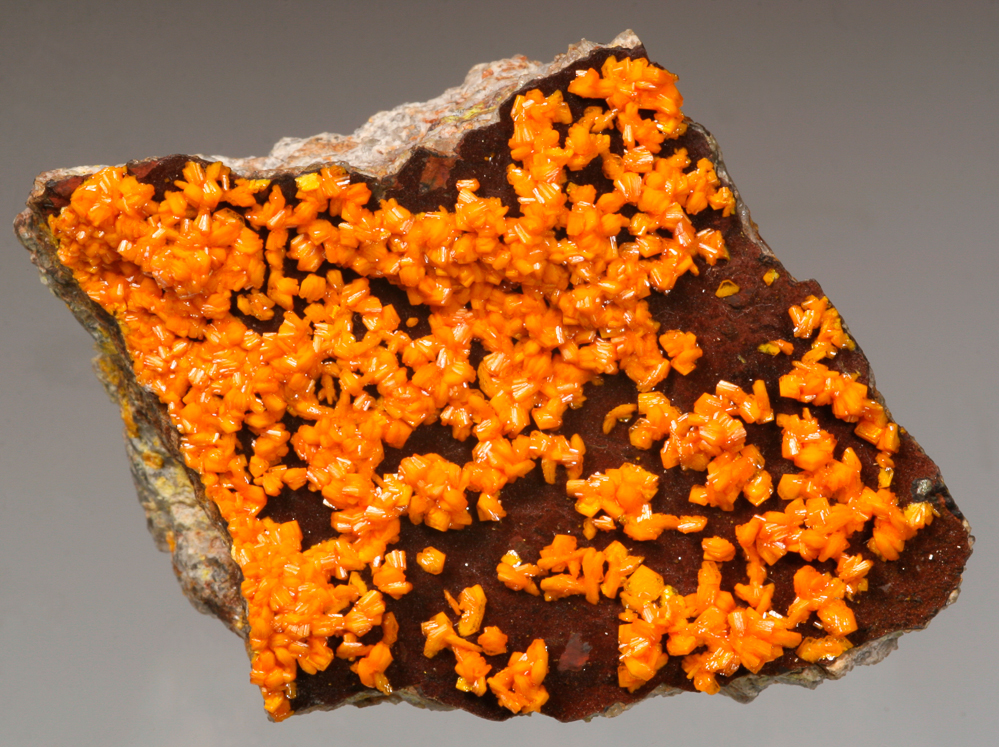
Francevillite, Mounana Mine, Franceville, Haut-Ogooué Province, Gabon – 4 cm
R. Lauf specimen and photo
The minerals were discussed with emphasis on different groups and structures. If this area is of interest to you, you might like to know that he has just published a new book, “Introduction to Radioactive Minerals”. (Please see the link below, under Links)
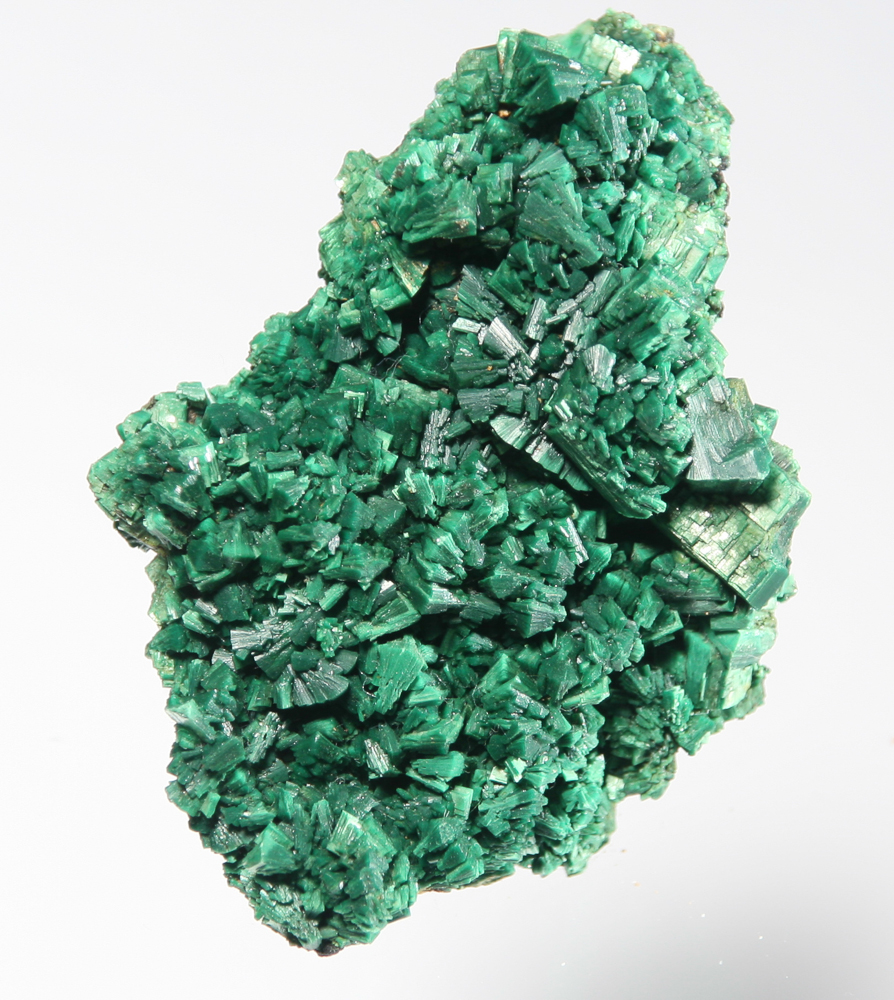
Torbernite, Margabal Mine, Entraygues-sur-Truyère, Aveyron, Midi-Pyrénées, France
R. Lauf specimen and photo
Gummite and uraninite, Ruggles Mine, Grafton,
Grafton Co., New Hampshire, USA.
Visible light (left) and radiograph, exposed 8 hours (right).
R. Lauf specimen and photos
Friday night, John Koivula presented “Crystalline Showcases”. John is a renowned photographer of micro features of gemstones, particularly inclusions – he has been active for fifty years, with over 800 published articles and notes.
Needless to say, the photographic journey over the course of this talk included many amazing images. Wild!
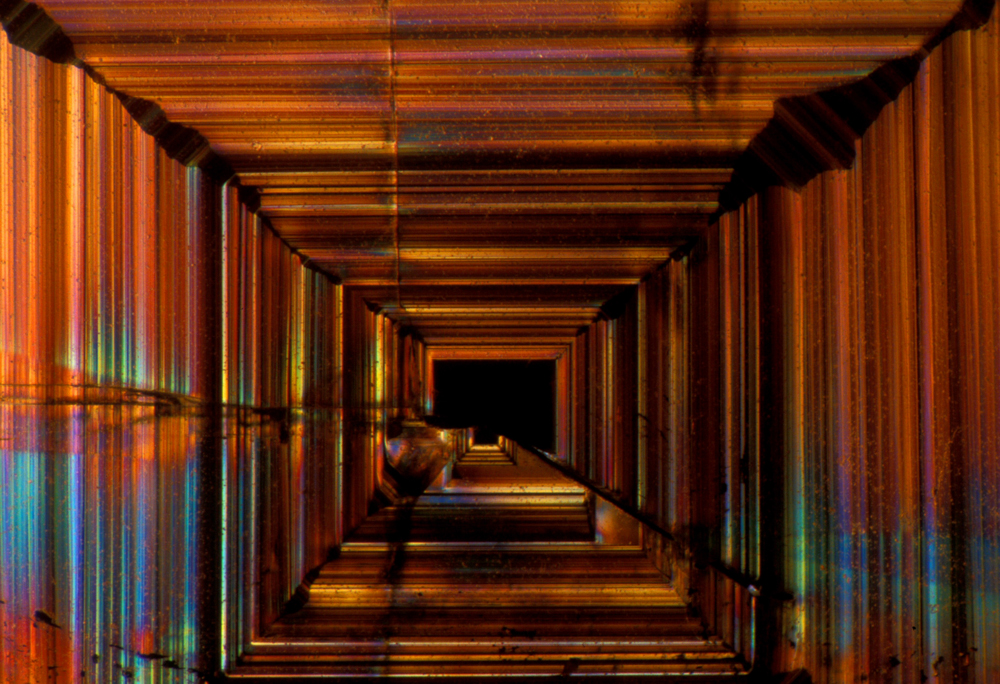 Cross-section through a Bolivian cassiterite showing fine growth. Field of view 2 cm (!)
Cross-section through a Bolivian cassiterite showing fine growth. Field of view 2 cm (!)
J. Koivula specimen and photo
Axinite – (Fe) inside Quartz, New Melones Lake, Calaveras County, California, USA
Field of view 0.9 cm. J. Koivula specimen and photo.
Technical Session
On Friday afternoon of the Symposium each year, Dr. Carl Francis moderates our technical session, “Contributed Papers in Specimen Mineralogy”. This is a packed afternoon, with talks strictly limited to 15 minutes. Abstracts from these talks are included in the Symposium program notes (link below), and they will also be published during the year in Rocks and Minerals magazine, so keep an eye out for them!
Saturday – Annual What’s New
After a second late night of folks having fun with mineral friends, one might expect a thinner crowd for the first talk Saturday morning… but Jeff Scovil leads off Saturday morning with What’s New in Minerals, so it’s a full house.
Not only is Jeff the world’s most published mineral photographer, but because he spends the year travelling the world to shoot some of the best mineral specimens there are, he is in a unique position to share. Jeff’s annual What’s New in Minerals each year at Rochester is a spectacular presentation not to be missed.
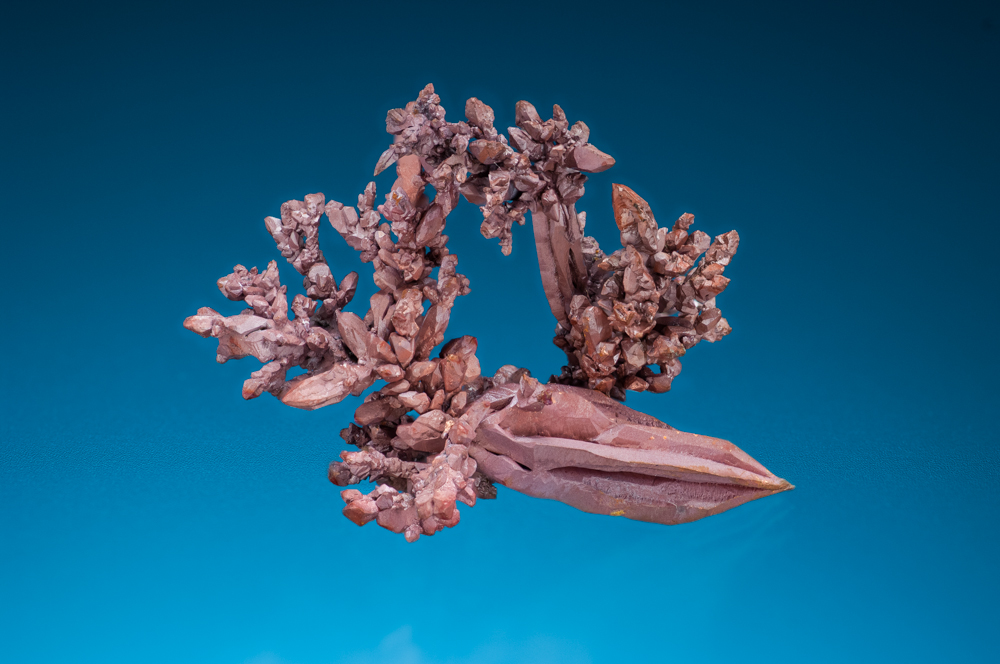
Copper, Bou Nahas, Alnif, Er Rachidia, Morocco – 2.9 cm wide.
Spirifer Minerals specimen, J. Scovil photo.
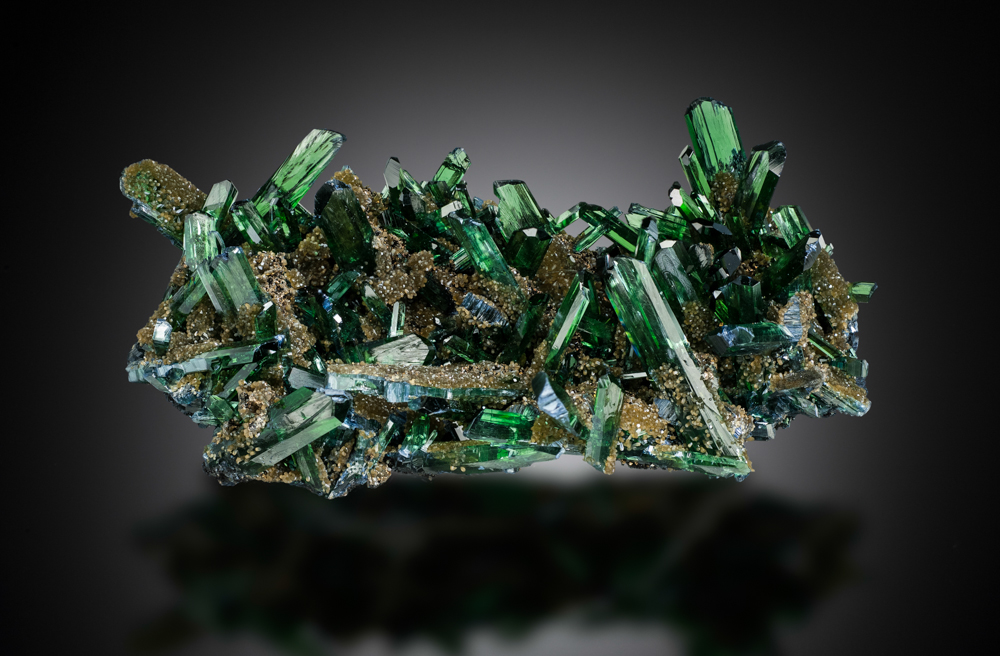
Vivianite. Huanuni mine, Potosi Dept., Bolivia – 12 cm.
Unique Minerals specimen, J. Scovil photo.
Spodumene var. kunzite. Mawi pegmatite Nuristan Prov., Afghanistan. 9.8 cm high.
Shafiee Muhammad specimen, J. Scovil photo.
Crocoite. Red Lead mine, Dundas, Tasmania, Australia – 9.3 cm.
Keith & Mauna Proctor specimen, J. Scovil photo.
Elbaite, Cruzeiro Mine, Sao Jose da Safira, Minas Gerais, Brazil – 15.1 cm.
Wayne Sorensen specimen, J. Scovil photo.
This is only a small taste of Jeff’s What’s New in Minerals presentation – it was an hour of photos like this! Each year, people hyperventilate, pass out on the floor and all that. (Ok, maybe they don’t really, but literally there are gasps, oohs and ahhs…)
All of Saturday morning is dedicated to what has been new in the past year in minerals. After Jeff, we have What’s New II, with other short contributions about finds and developments from Mineral World over the past year.
Since I am now spending a lot of time in a year pursuing minerals and then photographing them in a dark room, I included a few in a brief presentation. If you have been following along with the website over the past year, you’ll already be familiar with many of the specimens I included in my talk so I won’t belabour them here, but I’ll include three stories in case you missed any of them – two are not only cool but clarify the correct labeling for many incorrectly labelled specimens (and I’m including the third simply because it’s gorgeous).
Vibrant specimens from the Luputo Mine in the Democratic Republic of the Congo were initially labelled as chrysocolla when they first came out in early 2015. Subsequently, a posting on mindat by a mineral dealer, citing a vary authoritative source, labelled them ajoite. Labels all over the place were changed, to accord with the work done by the authoritative source. In fact, that person’s work was improperly represented. In completing the work subsequently, it was confirmed that they are in fact chrysocolla. They are chrysocolla pseudomorphs after malachite, after azurite, and they are covered with tiny pseudomorphs of chrysocolla after malachite.
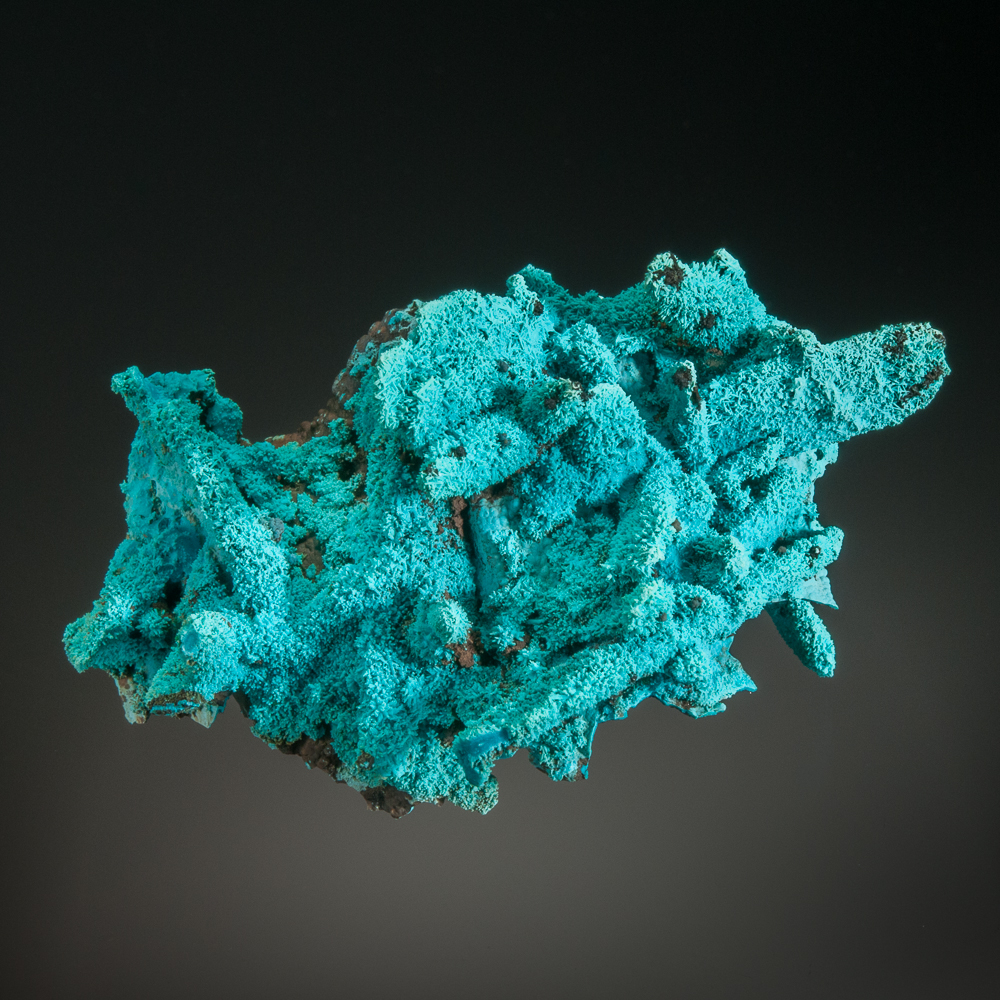
Chrysocolla pseudomorph after malachite after azurite, Luputo Mine,
Lubumbashi, Democratic Republic of the Congo – 8.1 cm
Another find from 2015 was the subject of more comprehensive identification work – the very cool pseudomorphs after marcasite and pyrite from the White Desert in Egypt. These were first offered on the mineral market in the mid-1990s, and have been brought out sporadically since then. They have repeatedly been labeled “hematite” (I can’t say on what basis, since the high-tech test I conducted with a streak plate does not produce a hematite result). Some have also been labeled goethite and others “limonite”(the latter no longer a valid mineral species name, but is a term still used in reference to unidentified iron hydroxides, so its past use has not been technically incorrect). In any event, recent substantial work by Hannah Allen at Hamilton College has confirmed that the White Desert pseudomorphs are predominantly goethite.
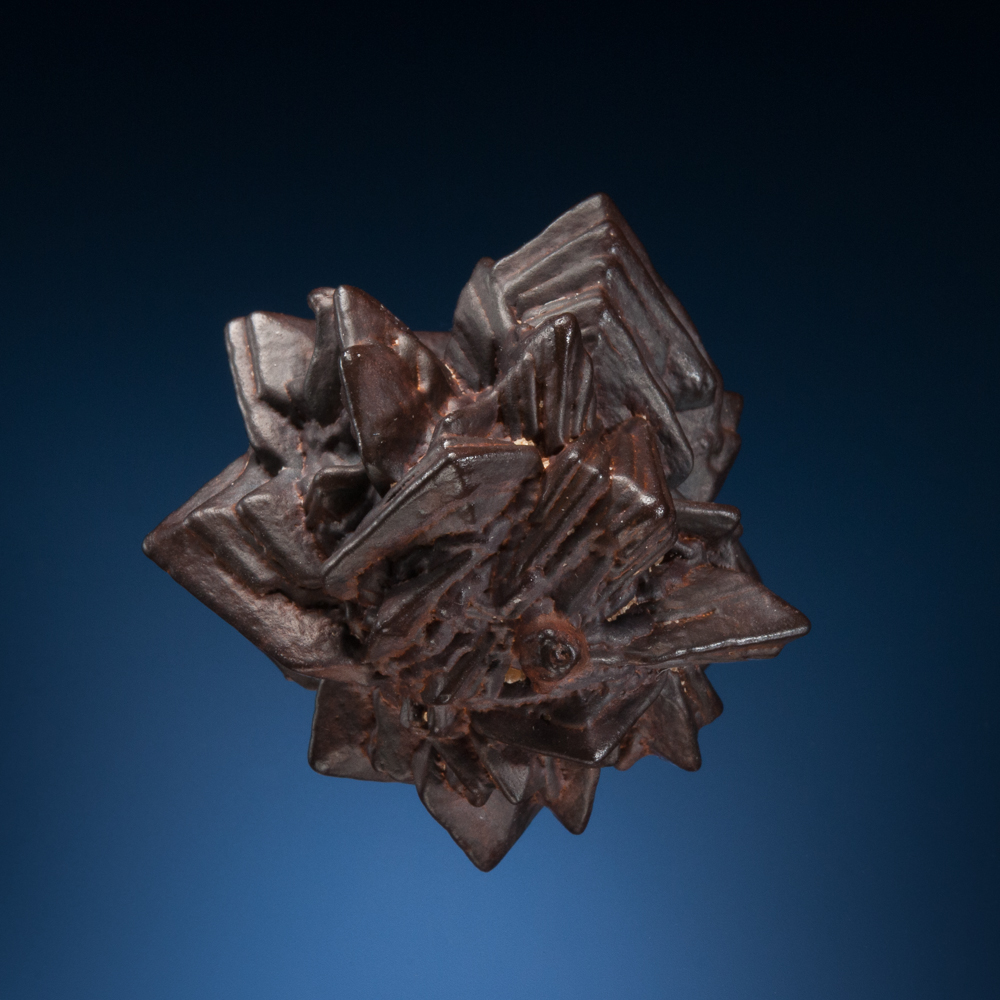
A new find at the El Hammam Mine this past year produced striking beautiful, glassy, yellow fluorite specimens. El Hammam is not known for yellow fluorite, rather it is most known for fluorite in hues of green, with associated dustings of pyrite.
Fluorite, El Hammam Mine, Meknes, Meknes-Tafilalet Region, Morocco
Field of view – 4.0 cm
An Unfortunate Development
Unfortunately, not all of What’s New is good news.
A piece of highly disappointing (the polite way to say it) news from Mineral World was presented by Frank Melanson. One of Canada’s most famous mineral collecting localities is finished. The Bear Lake diggings, in Highlands East, Haliburton Co., Ontario was a location for superb crystals of titanite, fluorapatite, phlogopite, orthoclase and amphibole minerals, along with many other minerals. Bear Lake was the type locality for the black amphibole now classified as ferri-fluoro-katophorite. An important part of Canada’s mineral heritage, thousands of people collected there, many as children, and many were inspired by Bear Lake to become more interested in mineral collecting. The locality was maintained, with significant help from the local collecting community, as a collecting site by the Bancroft and District Chamber of Commerce. We have learned that the Chamber of Commerce sold the property to a new private owner who prohibits any collecting. No-one in the collecting community had any word of this until it was a done deal, so there was no opportunity to save Bear Lake. The technical term of art for this kind of mineral locality development: it bites. Totally.
In case you are not familiar with Bear Lake minerals, here are a couple of of the many specimens I collected there over the years:
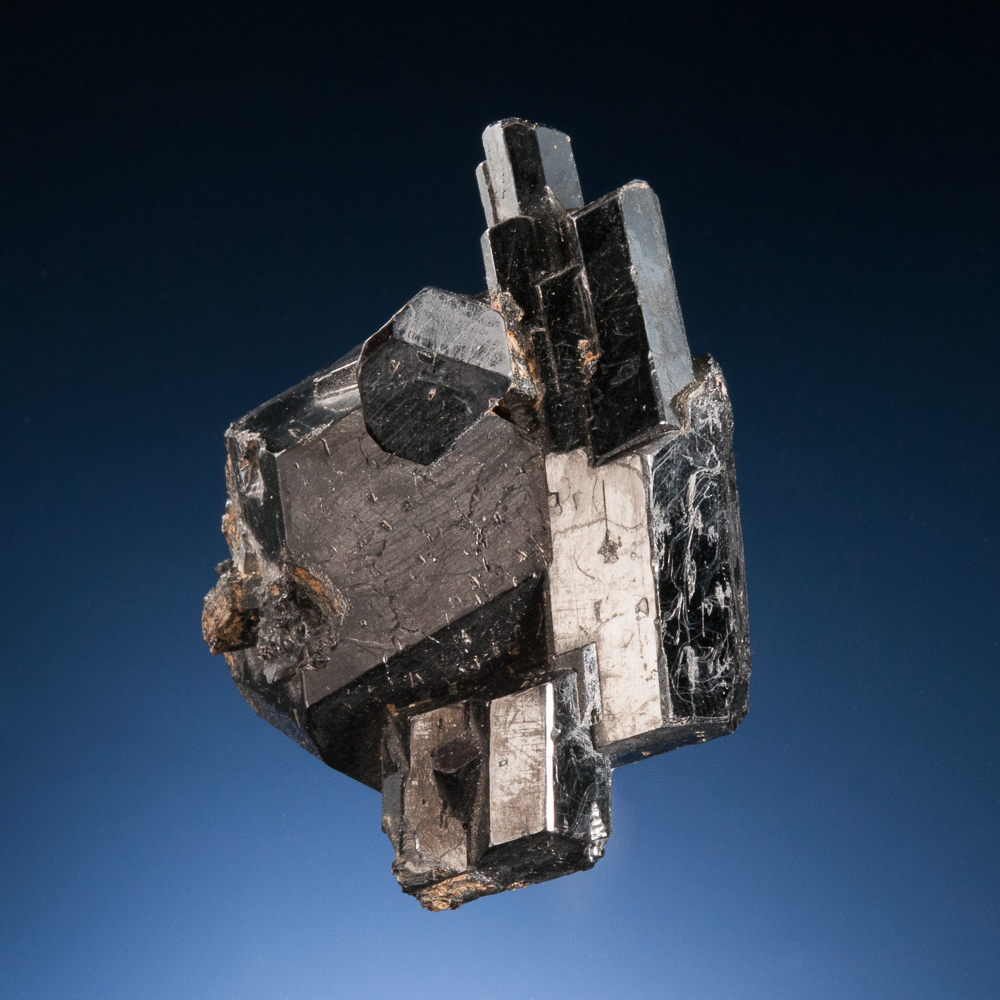
Ferri-Fluoro-Katophorite, Bear Lake, Highlands East, Haliburton Co., Ontario, Canada – 6.8 cm
R. McDougall specimen.
Titanite, Bear Lake, Highlands East, Haliburton Co., Ontario, Canada – 5 cm
R. McDougall specimen
More Saturday Presentations
Saturday afternoon began with Dr. Robert Martin, professor emeritus in the Department of Earth and Planetary Sciences at McGill University, and past editor of the Canadian Mineralogist – a role he undertook for 35 years (!).
As a small aside… once upon a time (a surprising number of years ago, now) there was a young history major starting at McGill. He was told by the university registrar that because his major was in the Faculty of Arts, the mineralogy course taught by Professor Martin was too hard and simply wasn’t for him. He took it anyway. Bob Martin taught me a lot about mineralogy during my time at McGill. I’ve always been grateful to have had that opportunity, and today I remember more of what he taught me than any of the history and other subjects I studied during those years.
Saturday afternoon, Bob presented The Minerals and Mineralogists of France. (Alas, no Bordeaux was served to accompany the talk.) This presentation was based upon Bob’s upcoming book, Canadian Mineralogist Special Publication 13 – Minerals Having a French Connection. It was a great talk that highlighted some lesser known minerals, locality photos and fascinating histories. For example, I was struck by some history about aerinite.
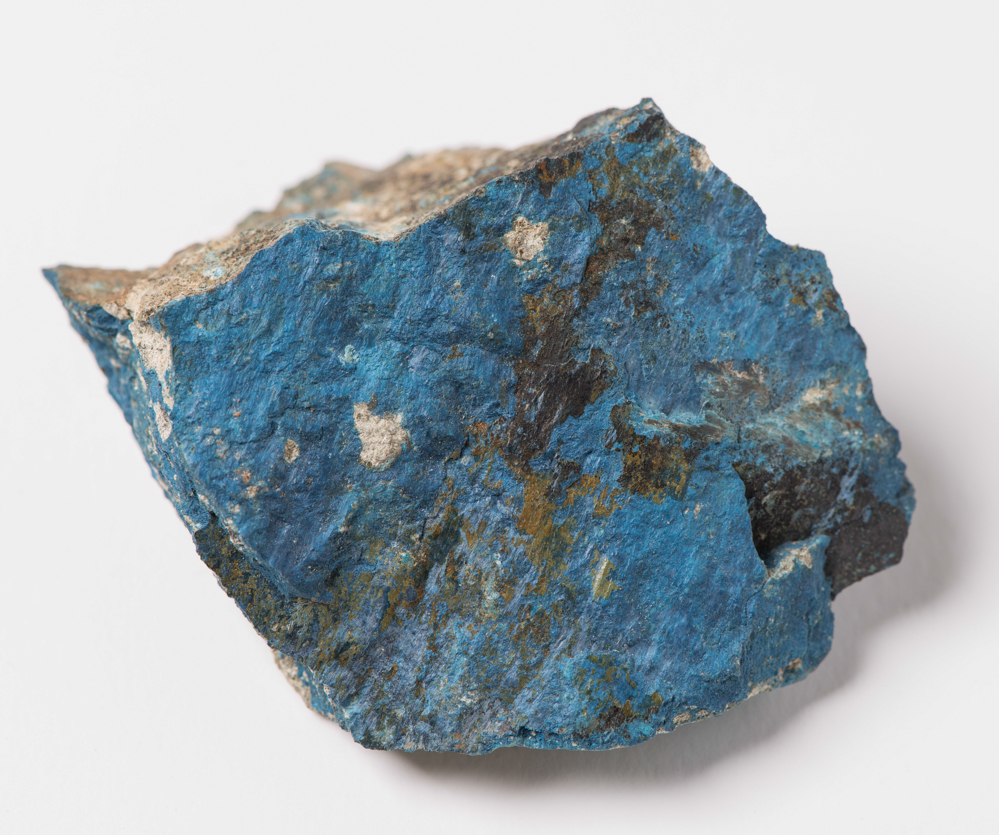
Aerinite, Estopanyà, Catalunya, Spain – 7 cm
R. Martin specimen, Russell Proulx photo.
This is a rare, complex carbonate-bearing silicate of a strong blue colour, from which it derives its name (named after the Greek aerinos, for sky-blue). The colour was so valued that, even though aerinite was not available in great supply, it was used in pigments in Romanesque paintings and frescoes in chapels along the Pyrenees. A truly barbaric thing to do to a rare mineral, but anyway…
Aerinite, used as a pigment by several Romanesque master painters. It is the blue of the Pantocrator from the apse of Sant Climent de Taüll church (early 12th century). This Romanesque fresco is now on display at the Museu Nacional d’Art de Catalunya in Barcelona.
I think everyone was wowed by the photos (from the upcoming book) of the rare mineral, tubulite. Tubulite was discovered at Le Rivet quarry, Peyrebrune ore field (Tarn), 6 km east-southeast of Réalmont, France. I’m including them both – is this a cool mineral or what? (Great photos!)
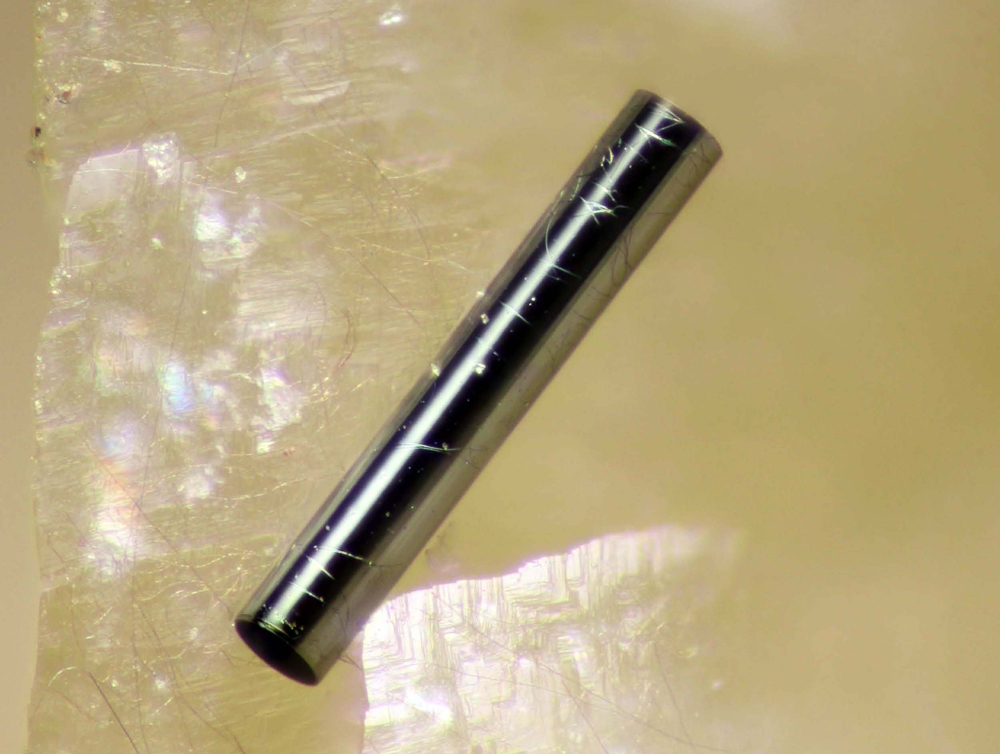
For our second Saturday afternoon talk, Elise Skawold, graduate gemologist (GG) and Fellow of the Gemological Association of Great Britain (F.G.A), presented “From Gemology to Mineral Physics and Back Again”. This talk provided a completely accessible glimpse into the realm of some rather high-level mineral physics applied to solve mineralogical mysteries. (The work featured in this presentation was done with Bill Bassett, Steve Jacobsen and John Koivula.) The central question in this particular mystery was the identification of an inclusion in a diamond crystal. One possibility was that the inclusion might be ringwoodite. Addressing the issue necessitated trips to various labs for different kinds of analyses.
Ringwoodite is not a mineral seen in mineral collections. It is a polymorph of forsterite, which is able to contain hydroxide within its structure. It is stable only at high pressure, such as in the Earth’s upper mantle, at depths from the surface between 400 km and 650 km. It is actually thought to be a highly abundant mineral in this zone of the mantle, but because it is not stable at the prevailing pressure at the Earth’s surface, finds of naturally-occurring ringwoodite is incredibly rare (sometimes found in meteorites). Ringwoodite is known in an inclusion in one Brazilian diamond – it was trapped in the diamond deep in the Earth and then blasted up from the depths during a diatreme explosion. The reason ringwoodite is of such interest is that the presence of ringwoodite in the mantle in such abundance is thought to indicate large amounts of water at depth (in the form of hydroxide) , below the Earth’s surface. Researchers are keen to find more ringwoodite inclusions in diamonds to help us to learn all we can about the water that may be harboured in the mantle.
In the end, this inclusion was determined to be forsterite.
Sunday – A Truly Grand Finale
Sunday morning’s program this year was special.
In some past years, by Sunday morning, the numbers have thinned a little. Survivors of three late nights of fun are few, and so we have sometimes seen smaller numbers Sunday morning. (You may be noticing a theme about late nights…) However, at recent Symposia, this has not been the trend – and this particular Sunday, the room was packed!
First up was a superb talk on the Vermont asbestos quarries at Belvidere Mountain (often erroneously referred to as “Eden Mills”, a town that isn’t the nearest and certainly isn’t at the locality). Ken Carlsen and Dr. Woodrow Thompson presented a history, explanation and mineralogy that was thorough and fascinating – I don’t know where the hour went (!). This presentation expanded upon their excellent article in the November-December 2015 issue of Rocks and Minerals magazine, “Belvidere Mountain Asbestos Quarries, Lowell/Eden, Vermont”. (If you haven’t yet red this article, it’s a great one – I highly recommend it!)
The earliest history was pieced together through some detective work and some great old photographs, including these two:
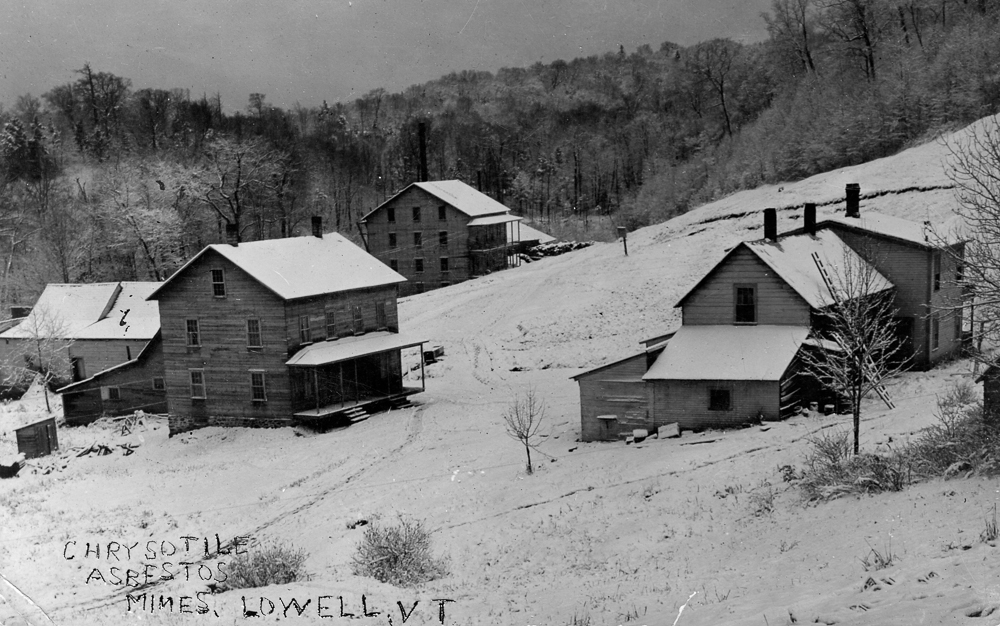
Lowell, Vermont, circa 1909. This settlement was originally known as “Chrysotile.”
The early Gallagher Mine at Belvidere Mountain, Vermont, circa 1909
There were also great photos from a more contemporary period, including some showing the pit areas where fine specimens were found at various times.
1980 photo of the mines, Belvidere Mountain, Vermont
State of Vermont Archives photo
The full photographic tour of the minerals of Belvidere Mountain is in the Rocks and Minerals article – here are a couple of teasers:
Grossular on diopside, Lowell quarry, Lowell, Vermont, Collected in the 1950s – 3.5 cm wide
Ken Carlsen specimen, J. Scovil photo.
Vesuvianite, Lowell Quarry, Lowell, Vermont – 2.5 cm
Ken Carlsen specimen, J. Scovil photo.
And last, but absolutely not least, the final talk of the 43rd Rochester Mineralogical Symposium was one that will always be remembered.
Our speaker was Canadian mineral photographer Michael Bainbridge. He is wrapping up the end of a major project with the Canadian Museum of Nature, a book on the truly unbelievable mineral collection assembled by Bill Pinch from the beginning of his collecting career and through the late 1980s, acquired by the Museum.
From the beginning of his collecting days, through to the late 1980s, Bill built a mineral collection like no other. It had incredible breadth of species, and top specimens of so many – many best of species. John White, former curator at the Smithsonian, has stated that Bill’s was the best private collection ever assembled. Many feel the same way. The Pinch Collection includes jaw-dropping specimens, one after another, after another… like this one…
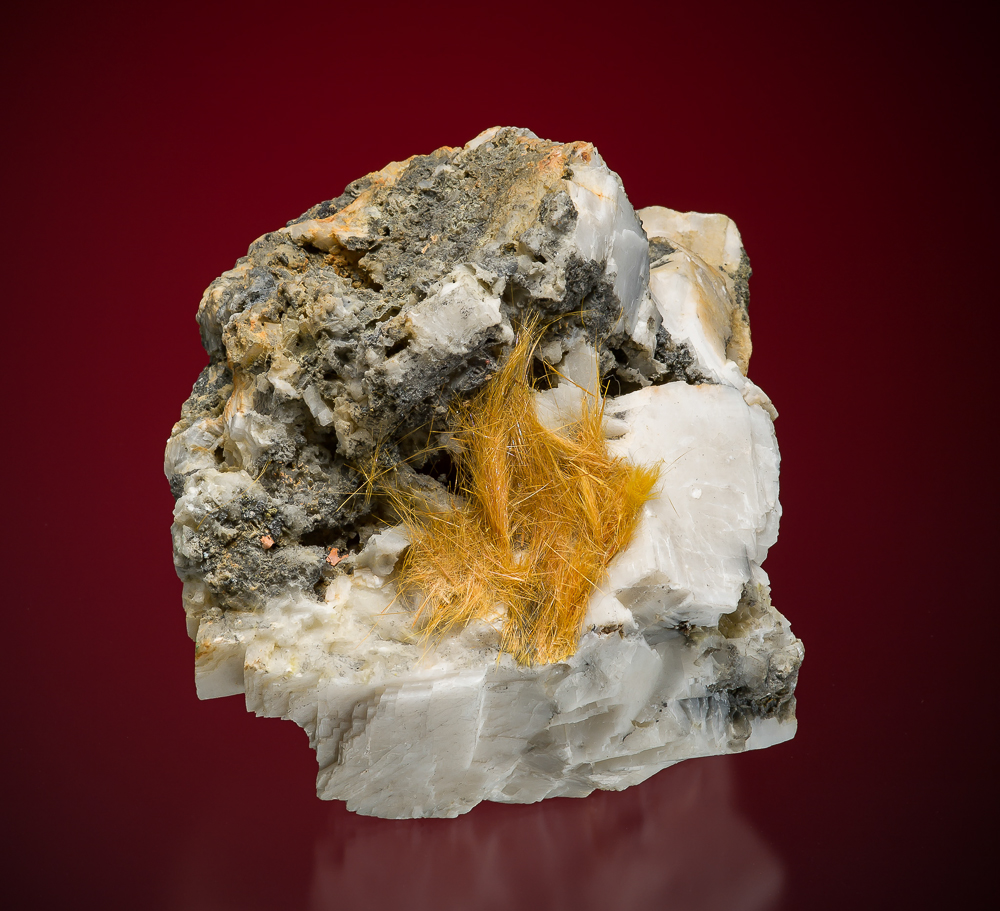
Wakabayashilite, White Caps mine, Manhattan, Nye County, Nevada, USA – 13 cm (!)
Bill Pinch Collection, now in the Canadian Museum of Nature.
M. Bainbridge photo.
And, given the material itself, it would have been a relatively straightforward undertaking to present a slideshow of highlights among the great specimens from Bill’s first collection. (Bill has been assembling another collection ever since…) However, although many of those highlights were of course included in the photographs accompanying the talk, Michael took a different, deeper approach, presenting stories of assembling the collection, surrounding the thesis that Bill, and the Pinch Collection, redefined mineral collecting and mineral appreciation at the time, and for all who followed.
Michael placed this story in the context of the era, the dynamics, and the influential players at the time, notably Paul Desautels. During the time period in which Bill built the collection, mineral specimens and collections came to be appreciated differently than they had in the past, and Michael highlighted Bill’s influence and the influence of Paul Desautels. The world of mineral collecting was forever changed during this era, and Bill’s role was fundamental. I don’t want to spoil the stories or the specimens for you – the book will be out soon and it will be an essential addition to mineral libraries worldwide.
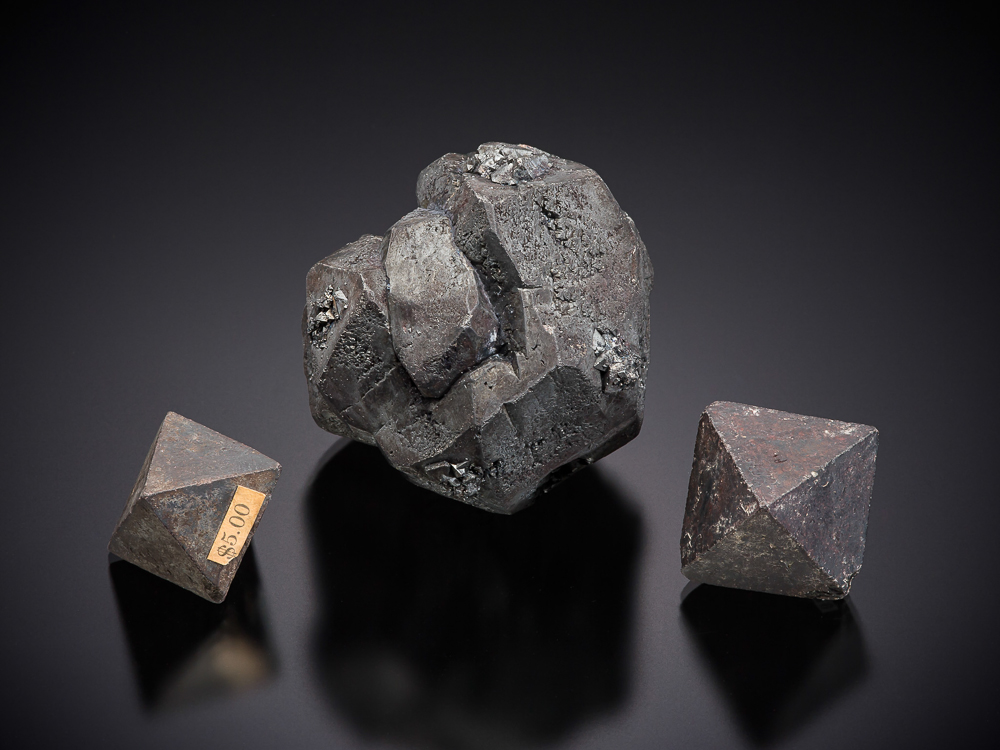
Hauerite, Radussa, Italy – largest crystal 5 cm, largest octahedron 3.5 cm
Bill Pinch Collection, now in the Canadian Museum of Nature.
M. Bainbridge photo.
Bill has always been the keenest observer of minerals, and the emphasis in his collections has been on both (1) the best, and (2) specimens with significance in mineralogy.
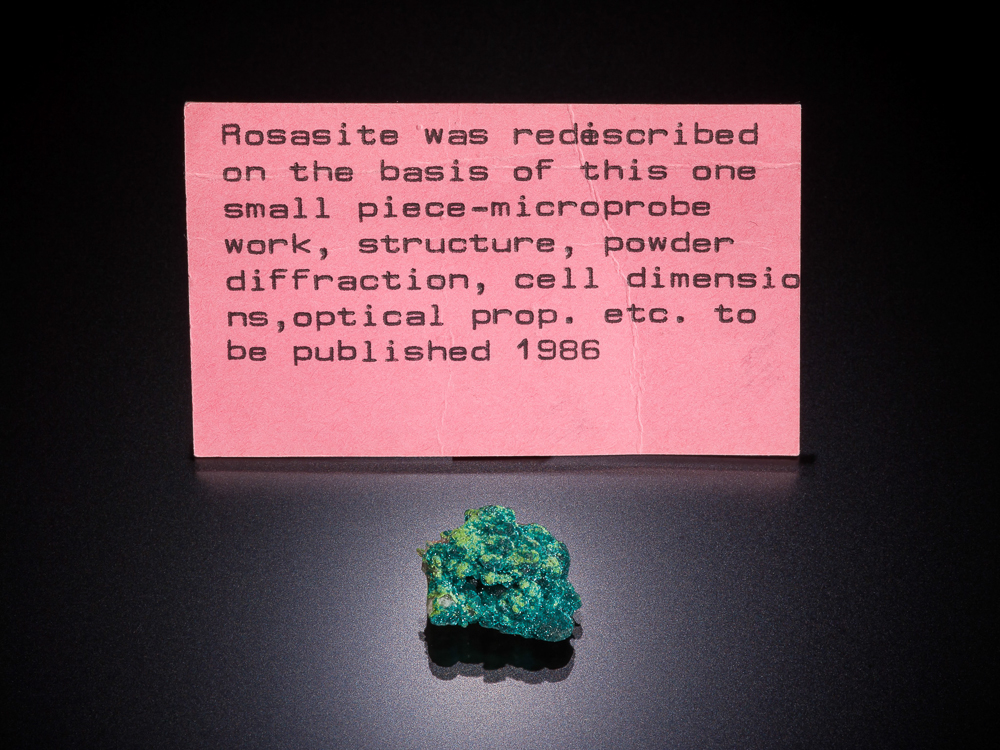
Rosasite, Tsumeb Mine, Tsumeb, Namibia – 2 cm
Bill Pinch Collection, now in the Canadian Museum of Nature.
M. Bainbridge photo.
As life would have it, Bill had not been present at the Symposium for many years. It is no exaggeration to say that it was a moving morning, as Bill, his wife Jackie and their son Michael attended the talk. They were greeted with the warmth that has come to be part of the Symposium – the Symposium that Bill himself has had such a major hand in creating and contributing to, over the years.

Bill Pinch, doing what he loves – carefully examining a mineral specimen and seeing something unusual
(often something no-one else sees at first!)
The book, The William W. Pinch Collection, will be published by Lithographie LLC and is expected to be 2017 – can’t wait!
Displays
As happens every year at Rochester, the Exhibit Room was full of great cases and beautiful minerals, some from individual collectors and some from museums.
The New York State Museum always has a great display. This year, the case was dedicated to the late Charles F. Hiler – the Museum recently acquired his collection. Chuck was a regular member of our Rochester Symposium family and will be missed. He specialized in the minerals of the Lockport dolostones of the region, and the case featured some superb specimens from the Penfield Quarry, just east of Rochester. Here are a couple:
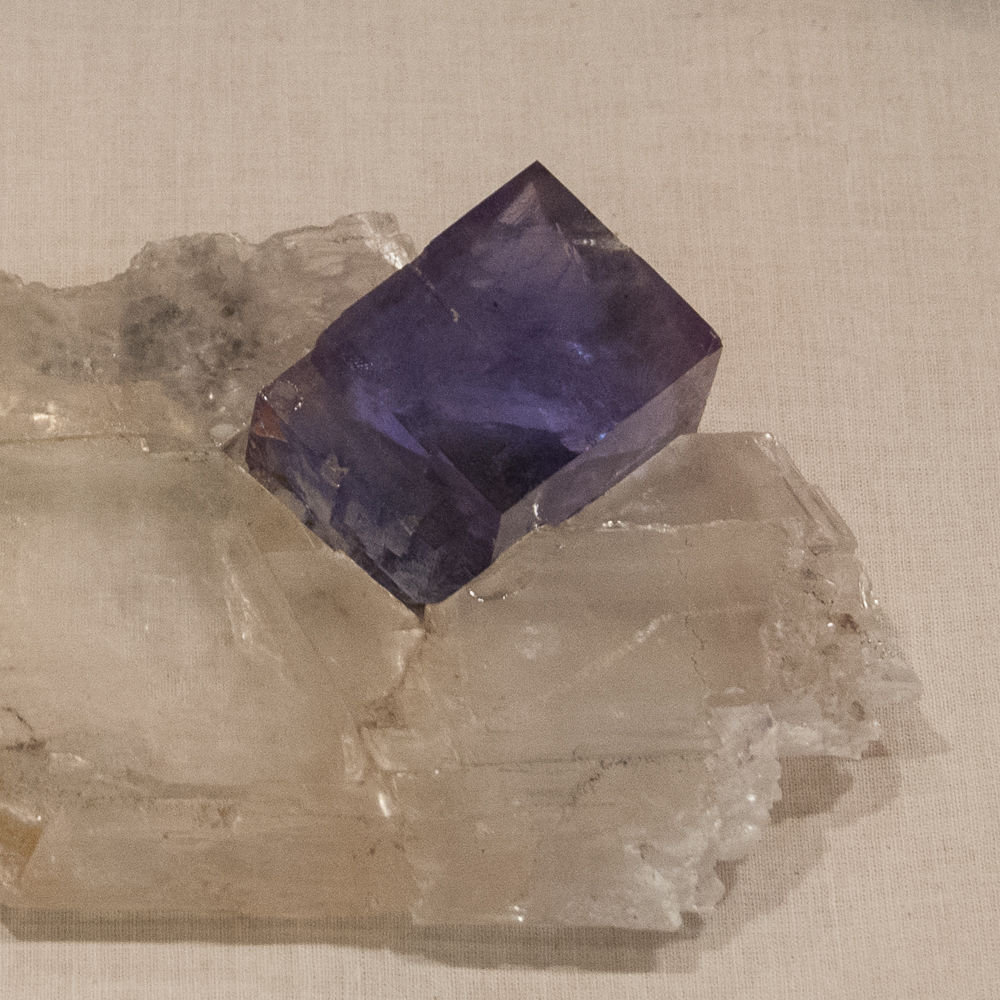
Fluorite, Penfield Quarry, Penfield, Monroe Co., New York – crystal approx. 4 cm
Gypsum, var. selenite, Penfield Quarry, Penfield, Monroe Co., New York – approx. 6 cm
Maine Mineral and Gem Museum case, Minerals Mined by Frank Perham
The schorl specimen in this case, collected in 1958, was particularly sharp – a great piece –
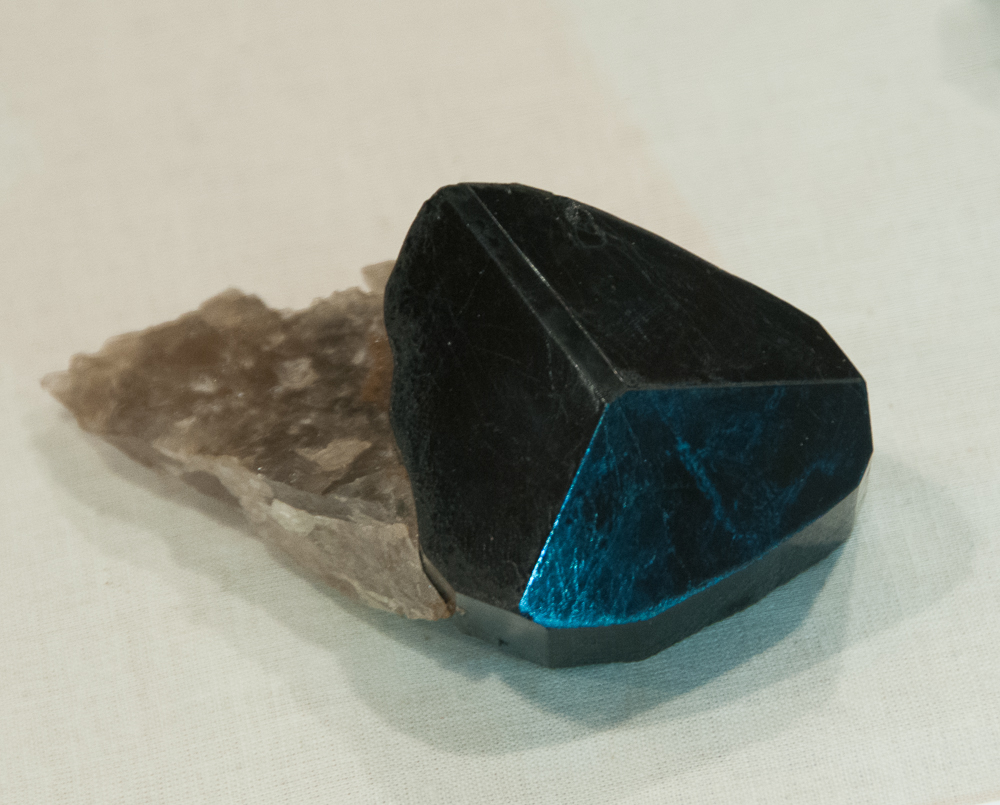 Schorl, Nubble Quarry, Greenwood, Maine
Schorl, Nubble Quarry, Greenwood, Maine
Crystal approximately 4 cm
The Cincinnati Museum of Natural History and Science had a great case of geodes from the midwest, with some particularly fine Indiana specimens from the collections of Terry Huizing and Gene Tribbey. This is a gorgeous golden barite in a geode:
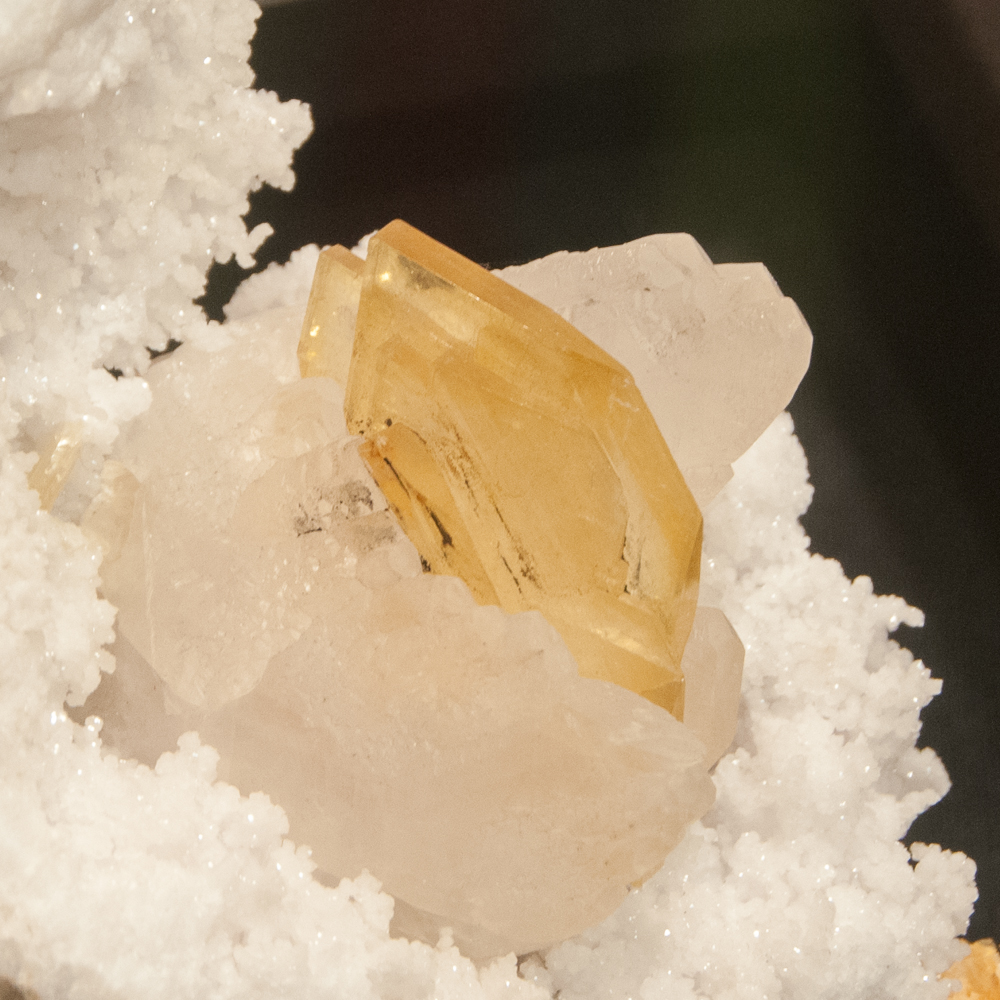
Barite, Monroe Co., Indiana, crystal approximately 4 cm
John Betts put together a case of beautiful specimens from his collection:
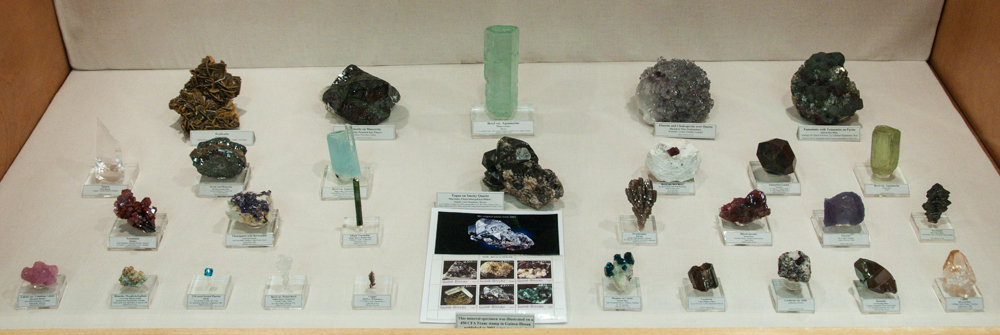
George Thompson’s case this year was dedicated to amethyst and associated minerals from the Thunder Bay District in northern Ontario:
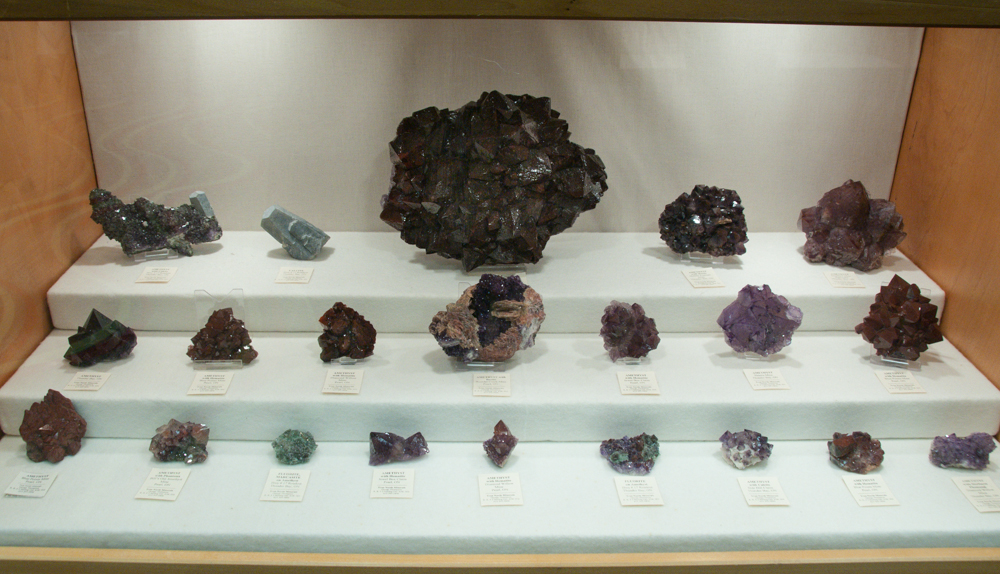
George included pieces from small find a few years ago that produced sharp, glassy, pale green fluorite crystals on hematite-included amethyst – these are excellent, colourful specimens (more so, in better light!):
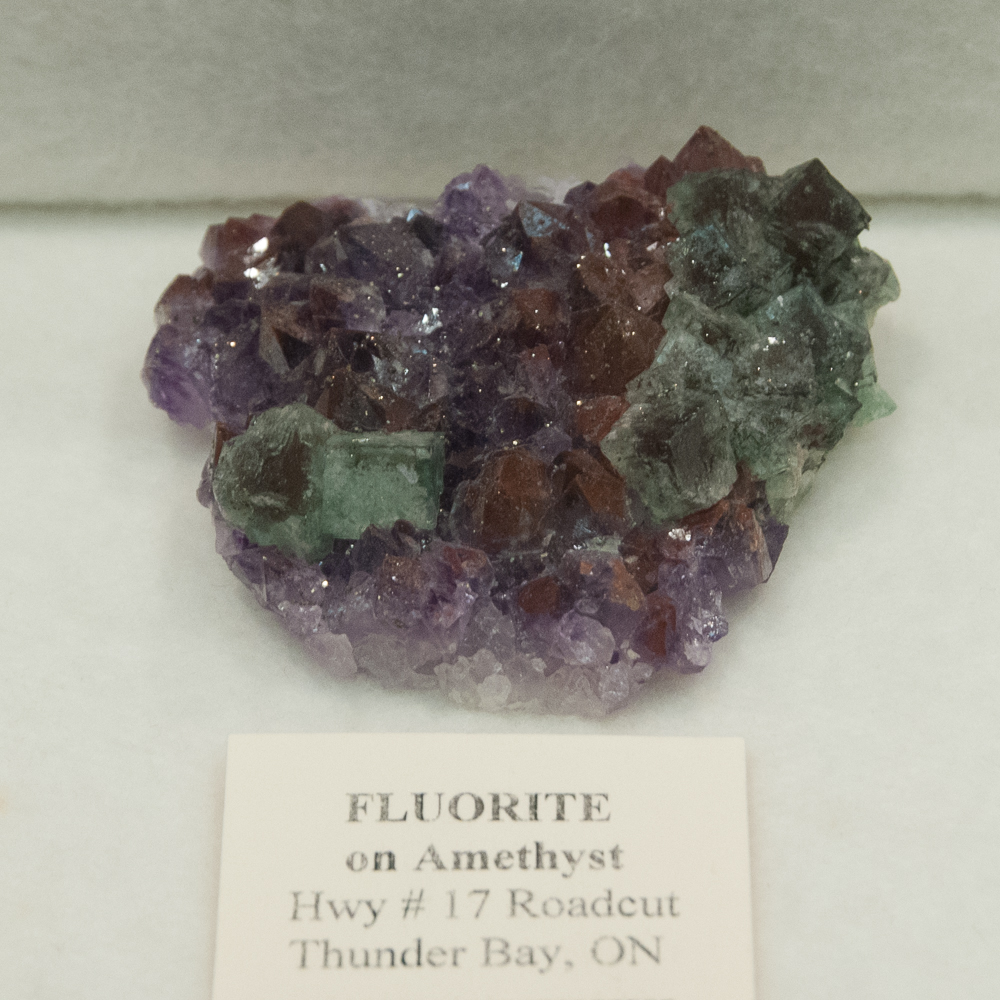
David Joyce had a great case of Canadian minerals, including a spectacular one from a new find in British Columbia – quartz crystals with amethyst sceptres. The sceptres have glassy, lustrous faces, even though that doesn’t come through in this photo. An amazing specimen!
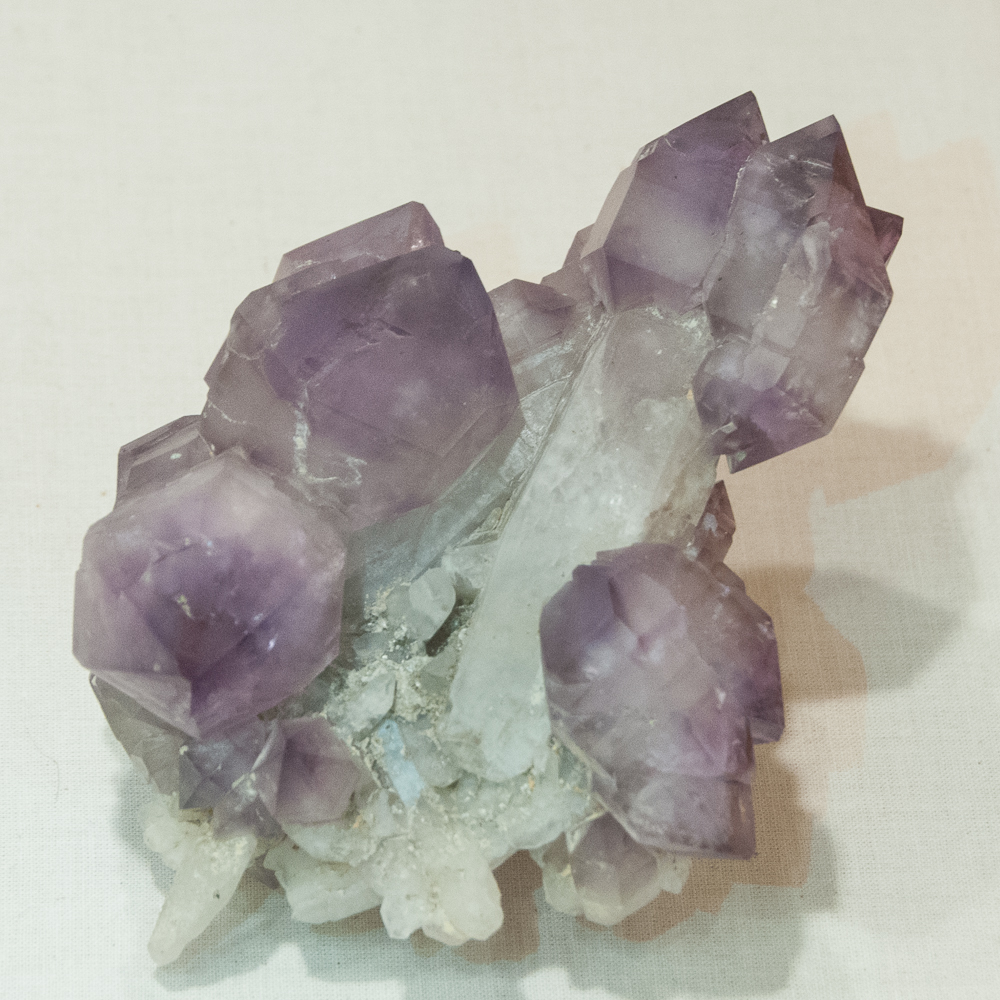
Quartz, var. Amethyst, Sanca Creek, Kootenay Lake, British Columbia, Canada – approximately 10 cm
The Rest of the Fun
As much as anything on the official program, lots of the fun occurs throughout the weekend as we all have a chance to socialize in the halls, over meals, and especially on the 4th Floor. This is the floor on which all of the dealers are set up – it is only open when the program is not on, but of course activities on the 4th Floor continue into past midnight and into the morning hours. It’s been a while since the 4th floor has seen Topaz Bowling (which apparently was not popular with all guests), but other fun continues…

An annual highlight is the Saturday night mineral song session with David Joyce.
John Betts photo.
By now I assume you all know Dave has a CD of mineral collecting and mining tunes… if you are not yet familiar with these them, they are popular collecting trip and mineral show fare. And if you aren’t sure what I mean by mineral collecting and mining tunes, you can check them out on his website at the link below. (Have an online listen to song # 9, The Mineral Dealer). By now, many of us know all the words, so Saturday night at Rochester is like a large campfire singalong. Except that it’s on the 4th Floor of the Radisson Rochester Airport Hotel, where fires aren’t welcome.
Until Next Year…
The Rochester Symposium is a great event. It has a rich history over its first 43 years, and it has seen many of Mineral World’s most prominent names as contributors. At the same time, the Symposium continues to embrace contributions from all levels in mineral collecting – it simply would not be what it is without everyone who contributes.
Of course, the Symposium could literally not happen without the dedicated efforts of the team who put it together – countless thanks to Steve Chamberlain (chair), Helen Chamberlain (registrar), and many others on the committee and those helping at the event and in the background, including Dan Imel, Carl Francis, Bruce Gaber, Brian McGrath, Bob Morgan, Betty Fetter, George and Susan Robinson, Quintin Wight, Elizabeth Von Bacho and Tom White. I hope I haven’t missed anyone!
And thank you to all of the speakers and photographers from this year, for all of your help with photos to share through this report
2017 RMS Speakers:
We have a super group of speakers to look forward to at the next RMS (except that very last guy might be a bit of a dud):
John Cornish, Frank Hawthorne, Bob Lauf, Renato Pagano, Herwig Pelckmans, Les Presmyk, Jolyon Ralph, Jeff Scovil, and me.
Links
If you are seeking links for anything mentioned above, some of these may be of interest:
The 43rd Rochester Mineralogical Symposium – Program Notes – April 14-17, 2016
Brad Wilson’s gemstones, including cut stones from Baffin Island, are here.
The new book by Robert J. Lauf: Mineralogy of Uranium and Thorium
The new Canadian Mineralogist Special Publication 13, Minerals Having a French Connection, is expected to be published in early 2017. It will be available from the Mineralogical Association of Canada’s bookstore.
Our amazing professional mineral photographers (who – of course – take photos of private collection specimens for individual collectors): Jeff Scovil and Michael Bainbridge
David K. Joyce has written – and plays and sings, of course – the soundtrack for so many great times in minerals. The tunes are available on itunes and the CD is available from Dave – if you’d like to hear them, here is the page where you can listen.


